


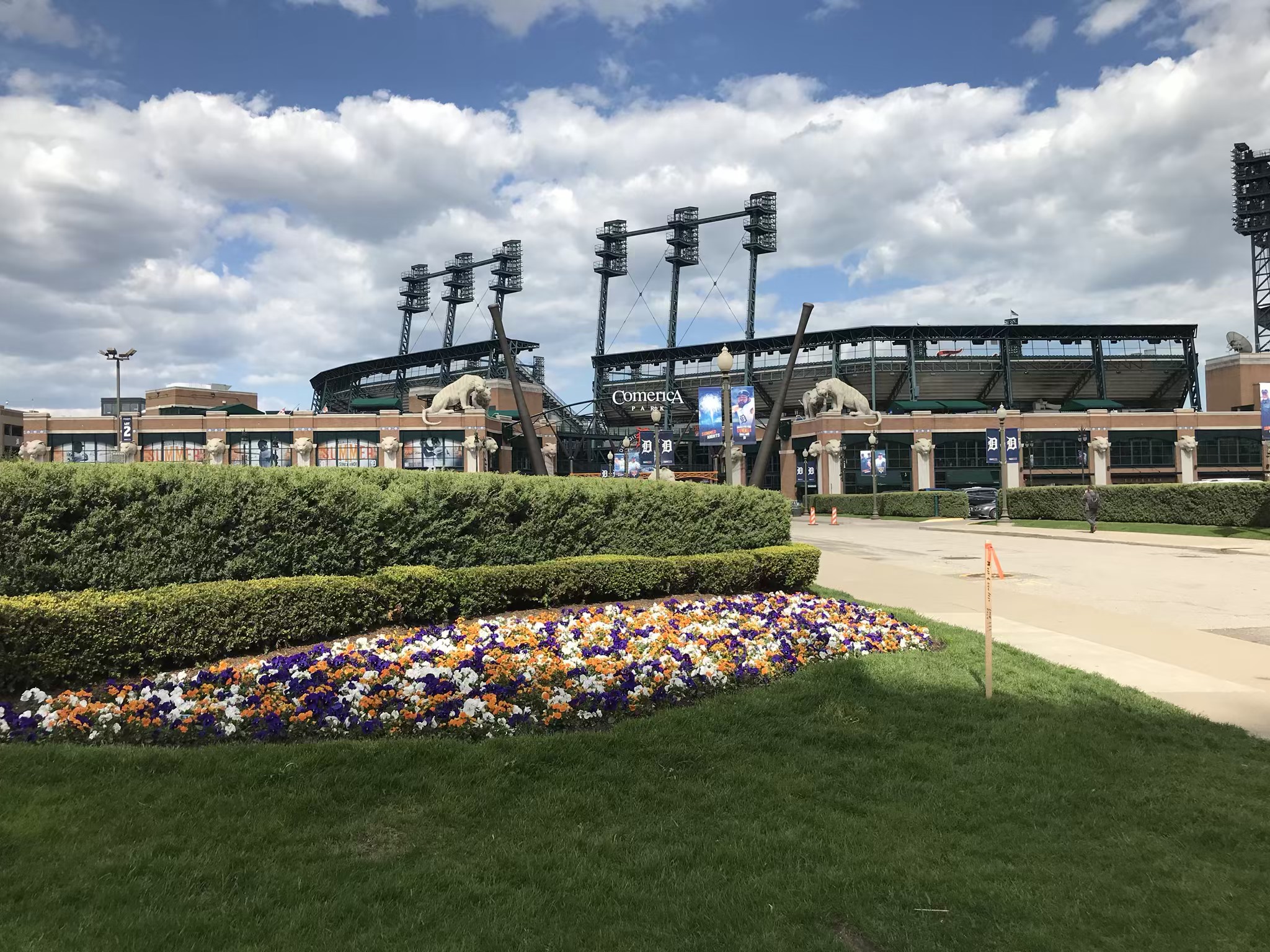
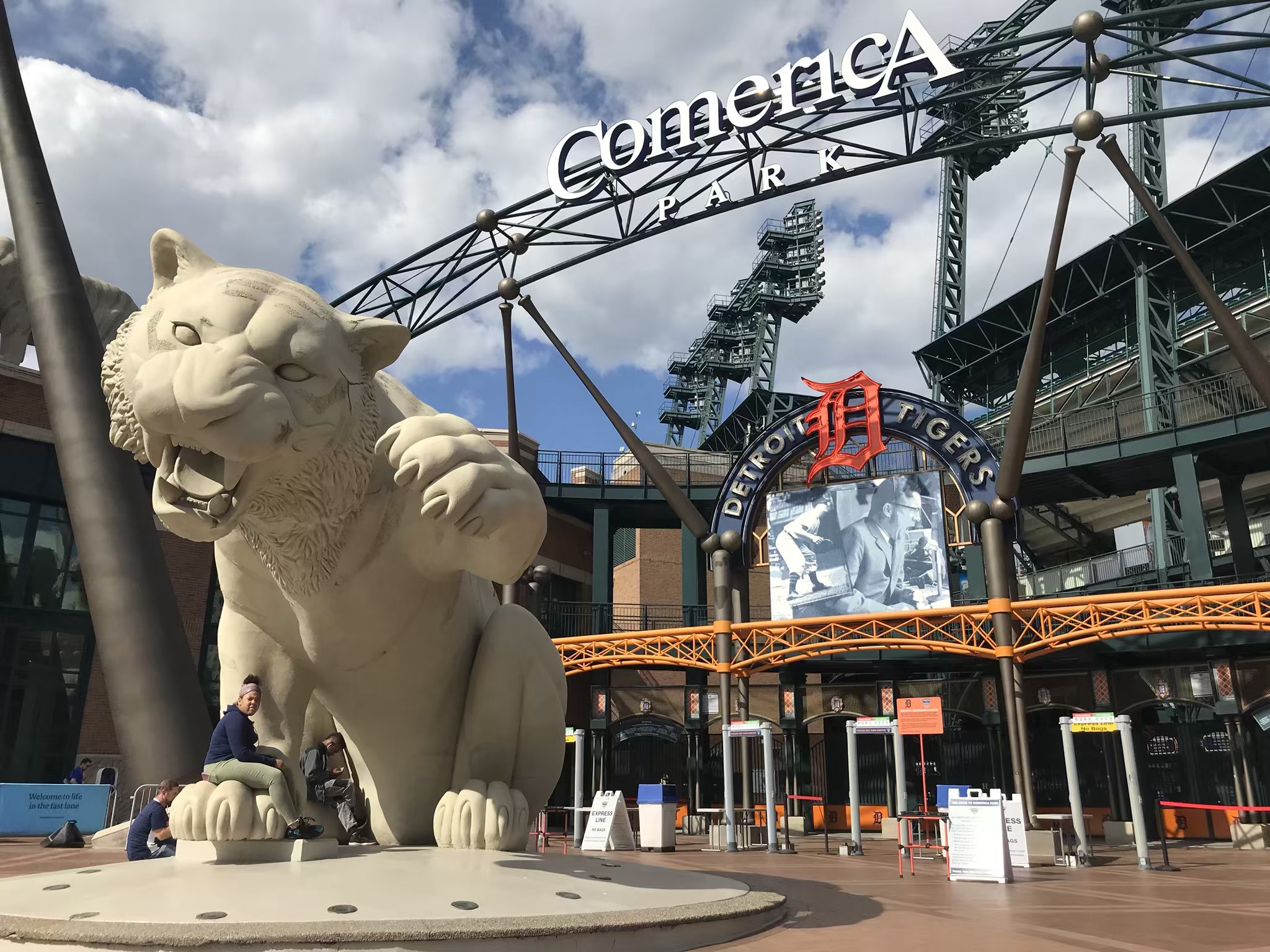
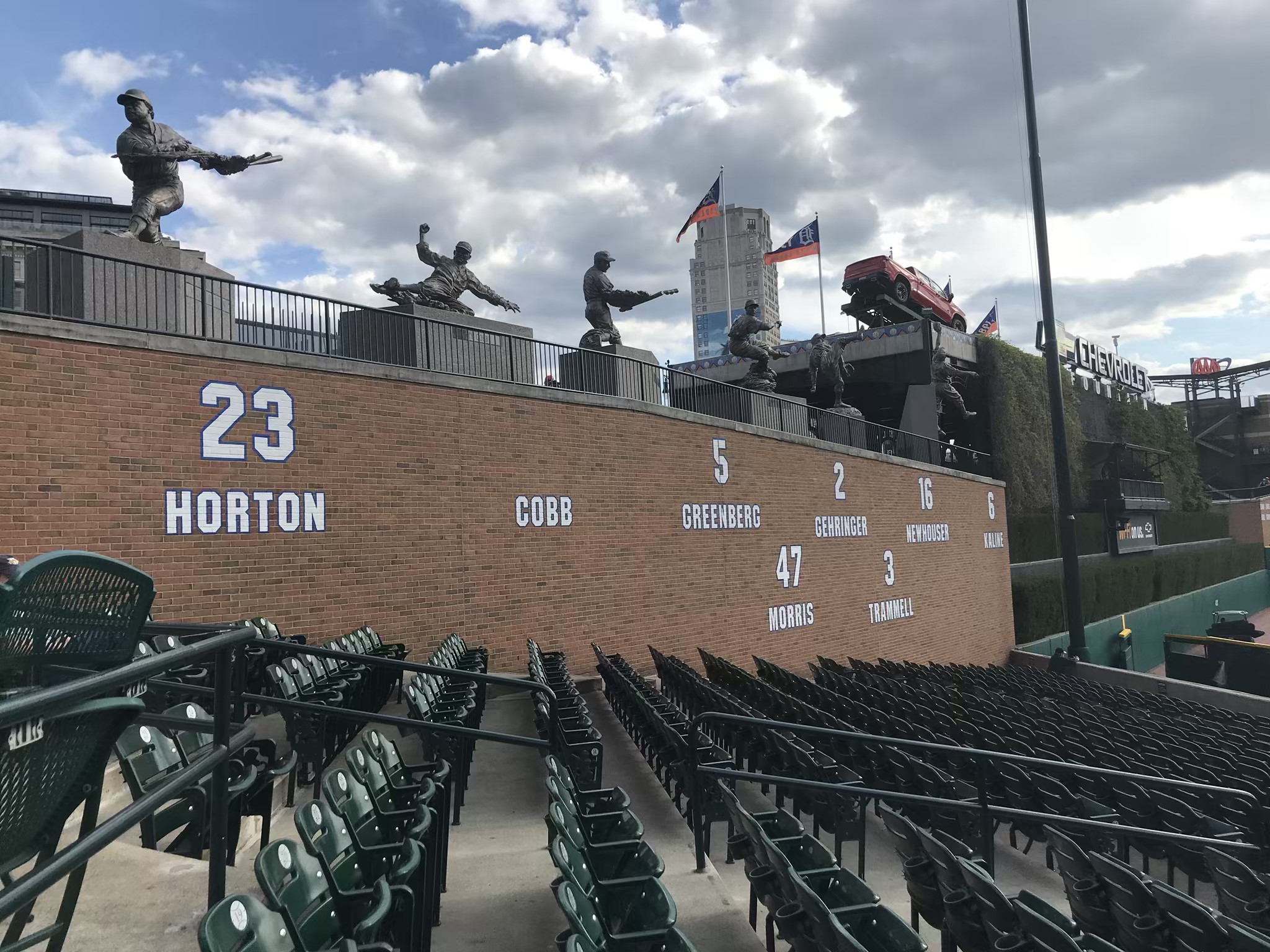
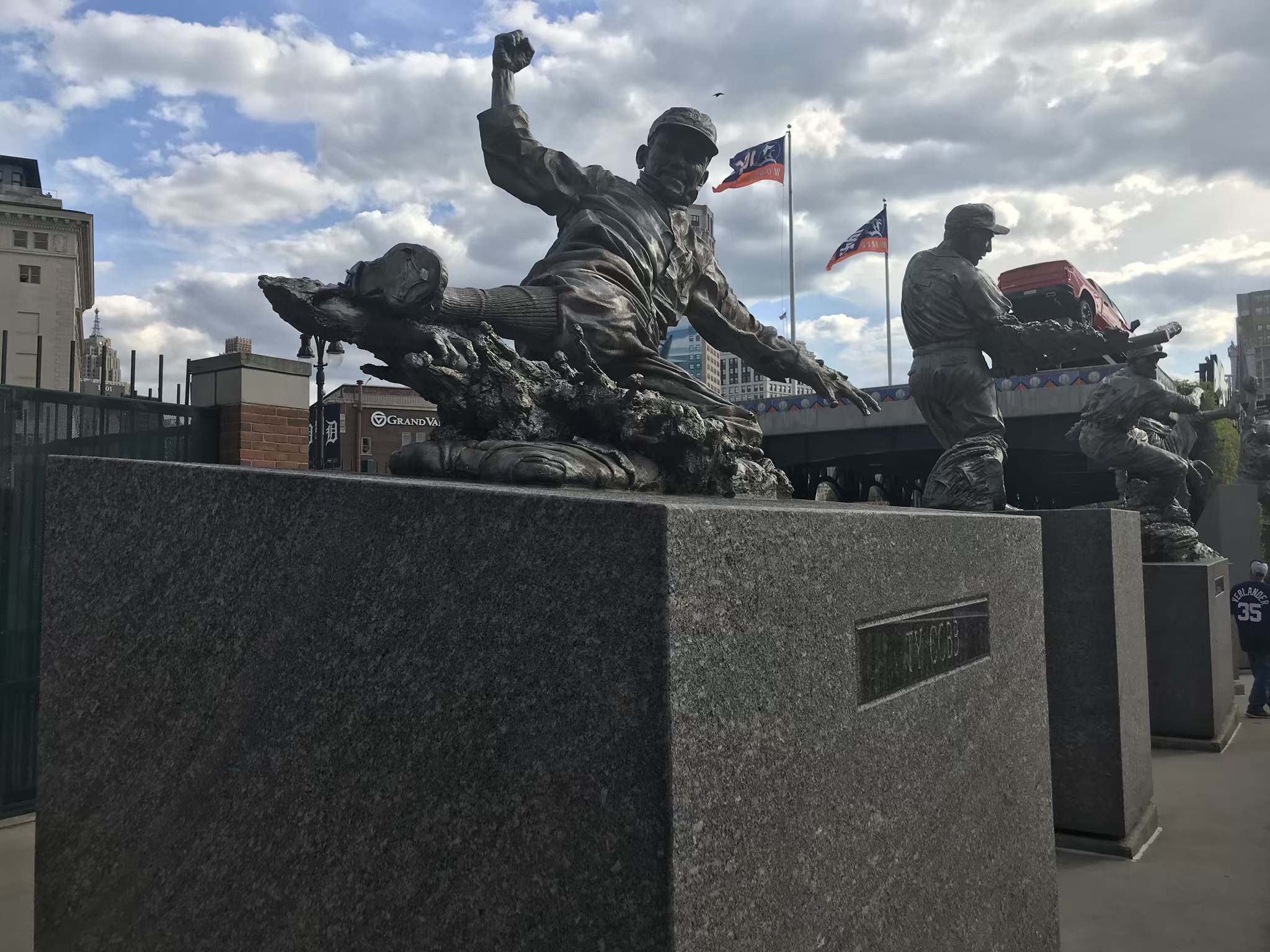
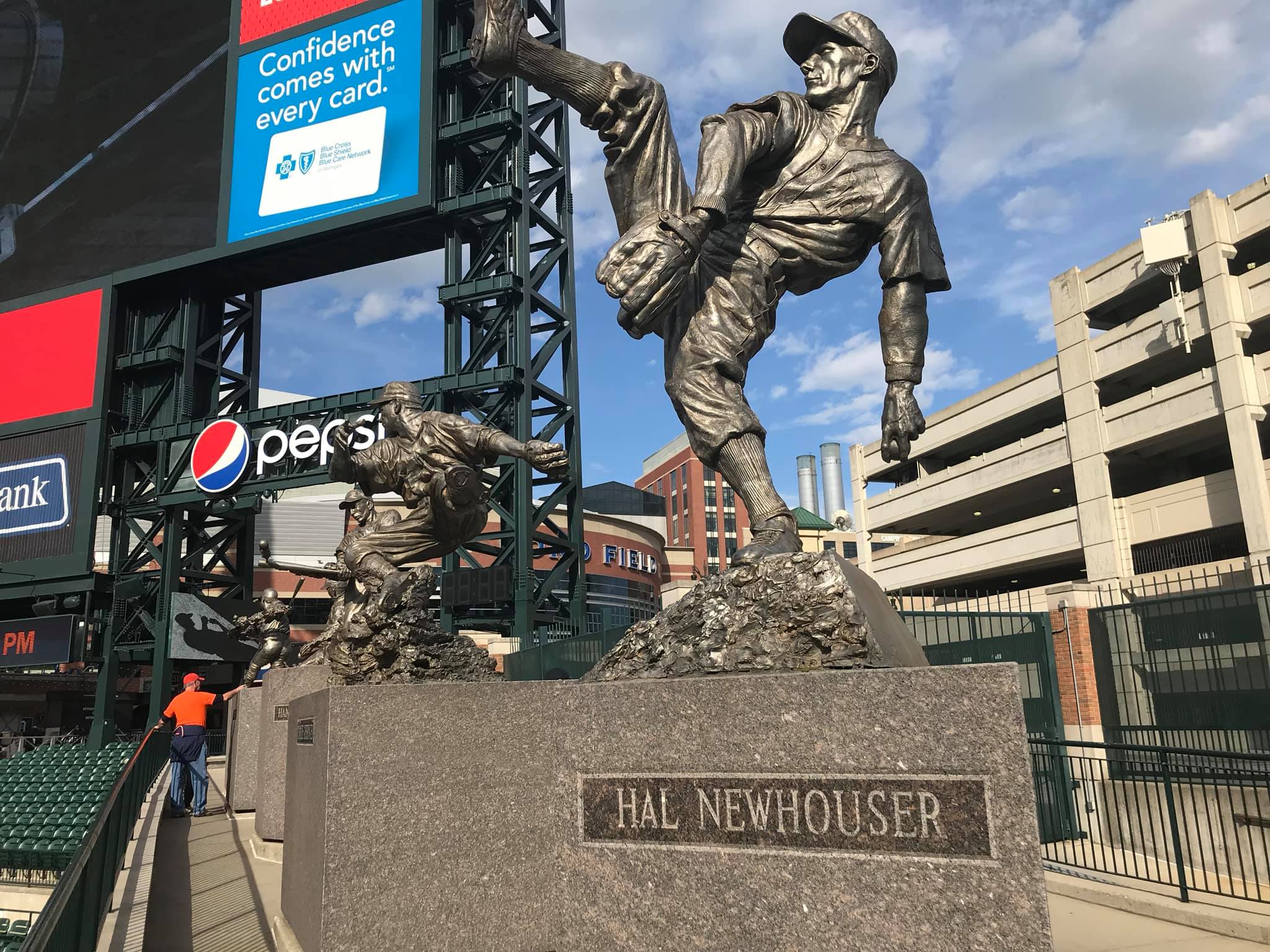
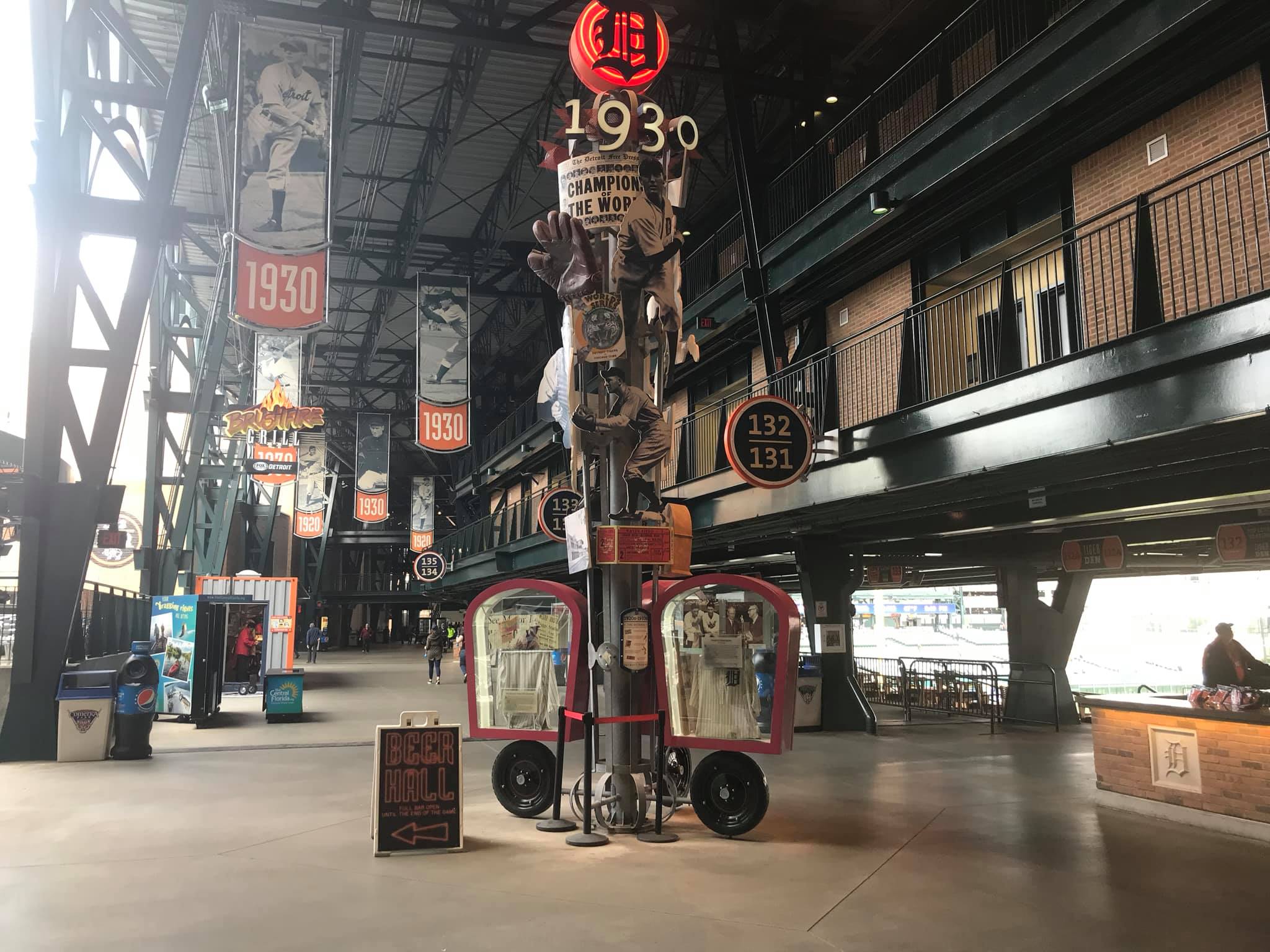
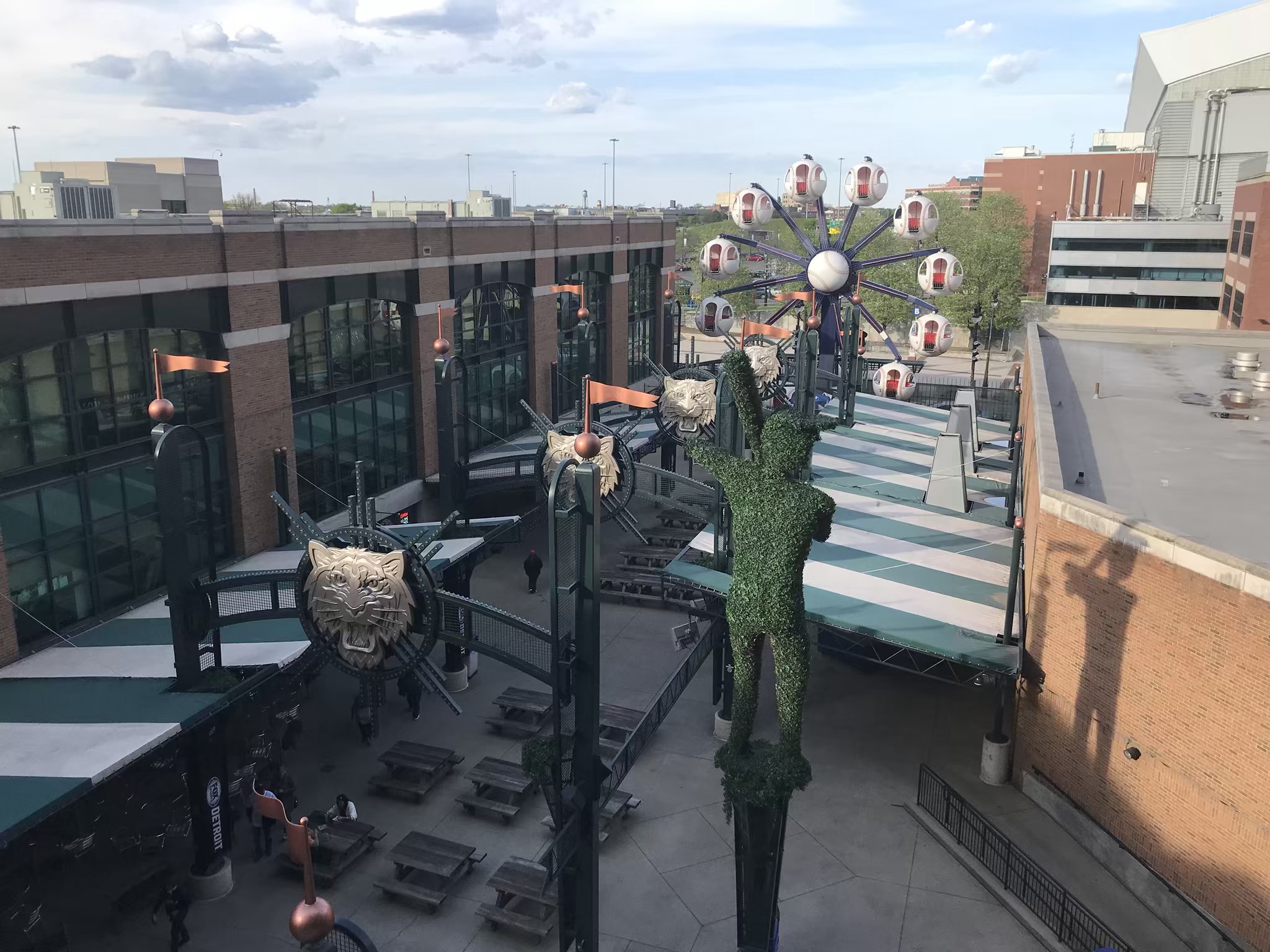
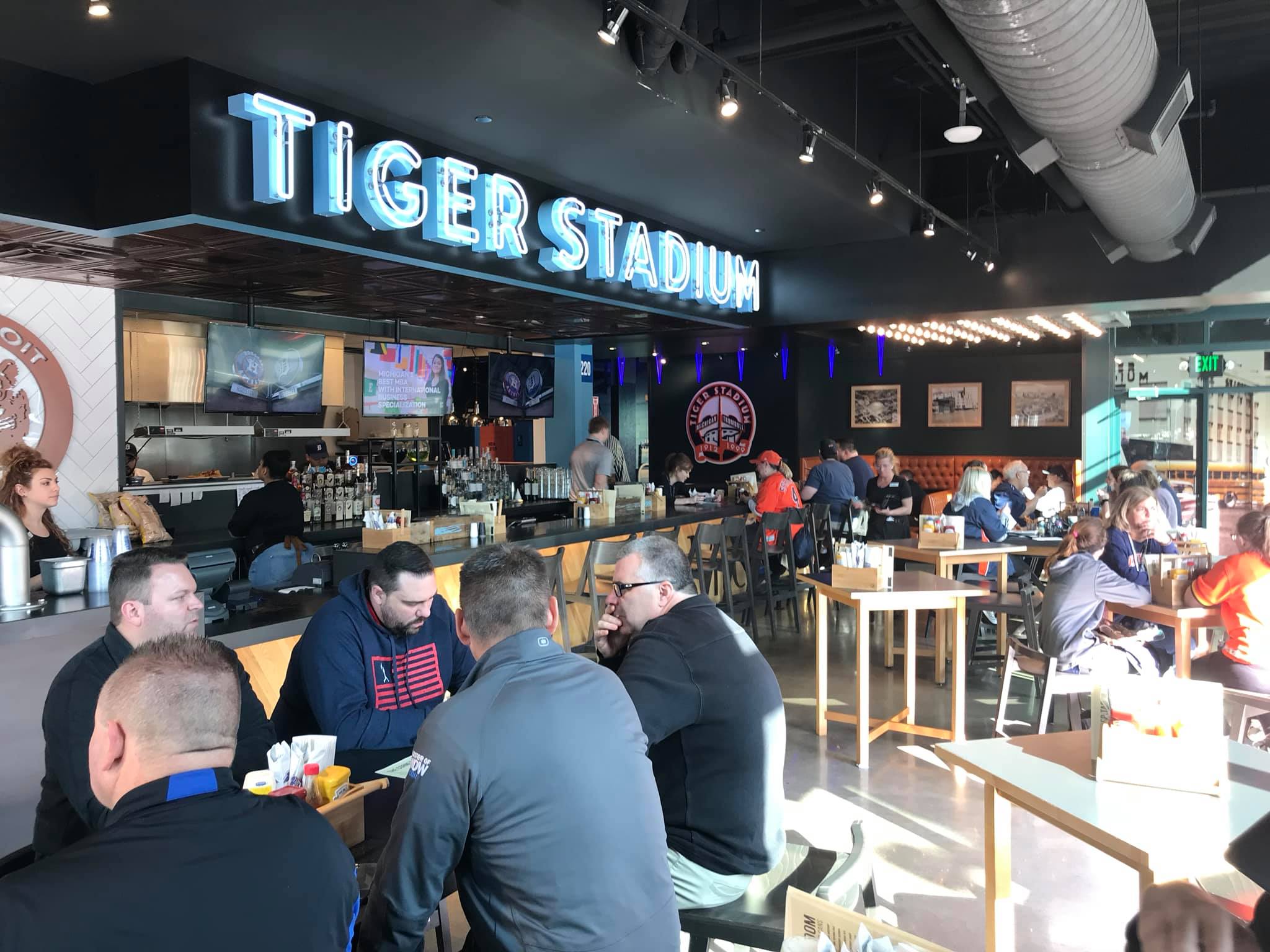
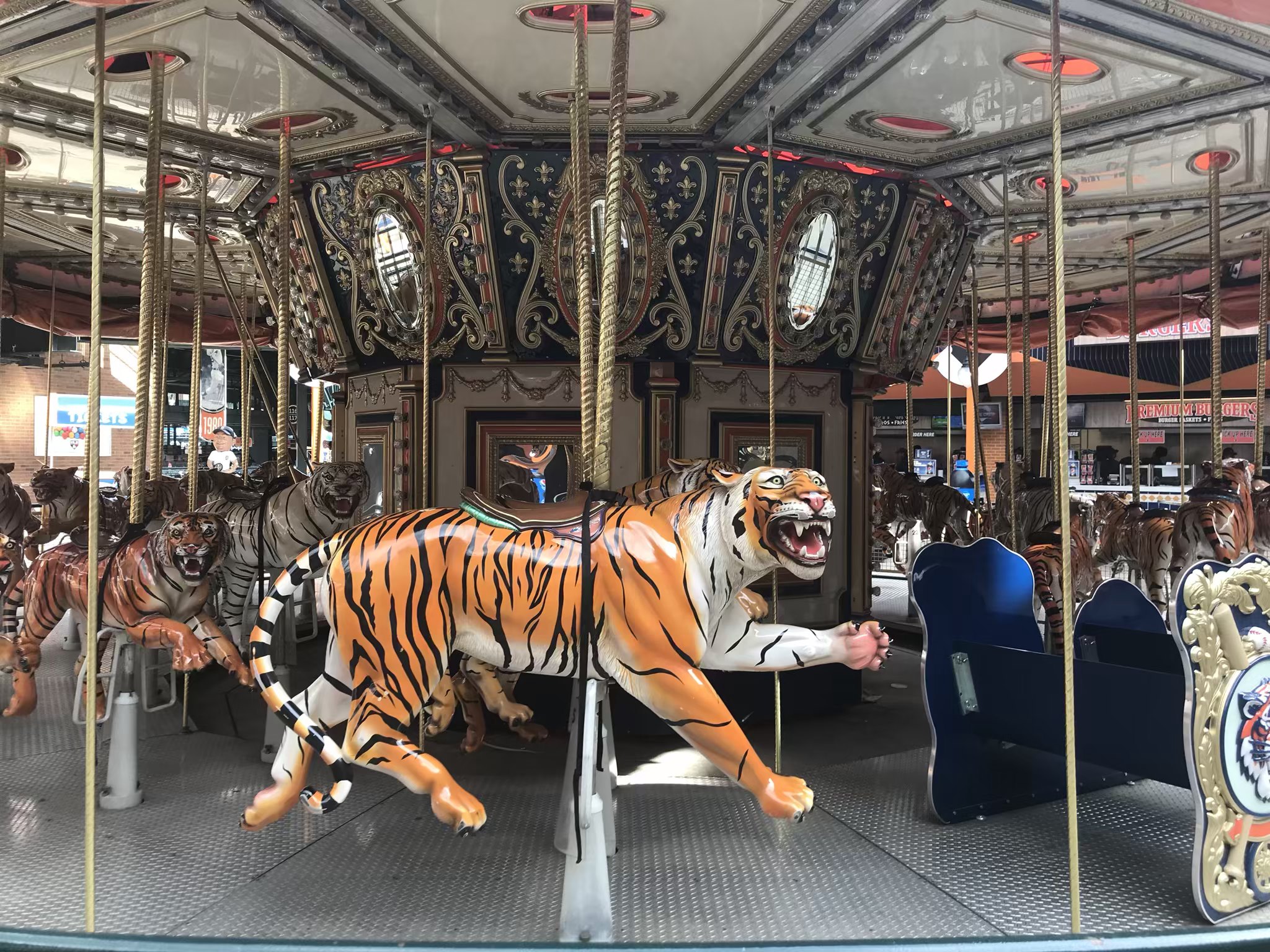
Comerica Park
| Setting | 16/20 | 1 Thumb Up |
|---|---|---|
| Locale | 4/5 | 1 Thumb Up |
| Accessibility | 3.5/5 | Thumb Sideways |
| Neighborhood Local Scene | 8.5/10 | 1 Thumb Up |
| Architecture & Aesthetics | 53/65 | 1 Thumb Up |
|---|---|---|
| Exterior Design/Aesthetics | 14/20 | 1 Thumb Up |
| Interior Aesthetics/Visuals | 35/40 | 1 Thumb Up |
| Concourse Aesthetics | 4/5 | 1 Thumb Up |
| Functionality & Essentials | 41/50 | 1 Thumb Up |
|---|---|---|
| Sightlines: Field Proximity | 11/15 | Thumb Sideways |
| Sightlines: Seating Geometry | 4/5 | 1 Thumb Up |
| Seat Comfort | 7/9 | Thumb Sideways |
| Concourse Functionality | 13/15 | 1 Thumb Up |
| Scoreboards/Tech | 6/6 | 2 Thumbs Up |
| Amenities & Features | 39.5/50 | 1 Thumb Up |
|---|---|---|
| Concessions: Food Variety | 3.5/5 | Thumb Sideways |
| Concessions: Food Quality | 3.5/5 | Thumb Sideways |
| Concessions: Craft Beer/Other Drinks | 4.5/5 | 1 Thumb Up |
| Social Gathering Areas/Restaurants | 9.5/10 | 1 Thumb Up |
| Premium Seating/Clubs | 4/9 | 1 Thumb Down |
| Historical Exhibits, Memorabilia, Art, & Other Displays | 9/10 | 1 Thumb Up |
| Kids Areas/Other Entertainment | 5.5/6 | 1 Thumb Up |
| Atmosphere, Vibe, & Policies | 10.5/15 | Thumb Sideways |
|---|---|---|
| Fan Support/Attendance | 3/5 | 1 Thumb Down |
| Ballpark Traditions/Gameday Presentation | 3.5/5 | Thumb Sideways |
| Ballpark Policies/Staff | 4/5 | 1 Thumb Up |
| Adjusted Raw Score | 160/200=80 |
|---|---|
| Bonus | 2 |
| Curve for All 7 | 7 |
| Final Score | 89 |
|---|---|
| Ranking | #7/30 |
|---|---|
Underrated Gem in Detroit
Confident in its classic yet understated design, well-rounded Comerica does about everything right, except not be Tiger Stadium
By: Cole Shoemaker
Written in 2011; ratings above are up to date for 2024, but this review below may be outdated and will be updated at some point; reviews and ratings are “living pages” updated yearly when necessary
Straight up: I love Comerica Park.
I came into this park with no pre-existing biases, but I’ve talked to so many Tiger fans who are deeply steeped in their belief that Comerica Park is an inherently inferior ballpark, especially in comparison to Tiger Stadium. If you are going to play the Tiger Stadium card, I’m never going to convince you. But you need to finally hear it: in comparison to the other new ballparks, Comerica Park isn’t just a good ballpark, but one of the best parks in all of baseball.
I think it’s clear that out of all the ballparks built in the last 25 years, Detroit’s palace is easily the most overlooked.
At first glance, Comerica Park appears to be another HOK (Populous) assembly line ballpark, but there’s more to it than meets the eye. It should be noted that some parks require a multi-game exploration to appreciate, while others such as AT&T Park in San Francisco and PNC Park in Pittsburgh automatically command attention with their views.
The bottom line is Comerica Park’s superior contextual integration creating prominent downtown views, along with ample space and incomparable amenities, make Comerica one of the best in baseball. Critics and fans have been slow to realize it, because it’s not Tiger Stadium. It’s not just me, as the folks from Baseball Fever and other ballpark websites to the New York Times have been claiming Comerica Park is extremely underrated for years.
But even I didn’t expect it to rate this highly.
I love the way Comerica physically integrates the team’s name and city into the structure unlike any other, spending so much time and money on the outside while showcasing one of baseball’s best skyline views outside. I love how it’s more objectively outstanding than many parks of the era, a fact no one seems to recognize. I love how it doesn’t try to divide fans along hierarchical lines, but still provides all the requisite high-end amenities. I love how the Tigers made the concourse a walking museum, weaving in a sense of history into the main areas of the ballpark. At the same time, I love how Comerica includes some of the best over-the-top family-friendly amenities, but most importantly, tastefully relegates them (Ferris Wheel and Carousel) off the main concourse. So many parks get this backward: they stash the awesome memorabilia in an obscure area, while intrusively placing kids playgrounds on the main concourse, creating a mall-like atmosphere. I love the simplicity of the interior design, which completely avoids loud quirks without being boring and bland, a very difficult balance to achieve. No fake rocks, sand boxes, or choo-choo trains here. It’s beautiful without a distinguishing feature.
Most of all, I’m fascinated by the irrational hatred the ballpark gets for not being like Tiger Stadium.

This baby was never given a chance, and not just because it was following Tiger Stadium. Nationally, maybe it had to do with the other two ballparks that opened in 2000, AT&T Park and Minute Maid Park. Both received much more fanfare for obvious reasons.
AT&T Park was the most scenic facility ever seen, and Minute Maid Park was one of the loudest parks ever seen, with its innovative interior design, numerous quirks, and home runs. Comerica was also strongly derided for its ridiculously cavernous dimensions. We can all agree they were originally absurd.
What’s most striking is the outcry from the locals. As much as it pains me to say, Tiger Stadium simply can’t be mentioned in the same breath as Fenway or Wrigley in terms of 21st century viability, fan support, or aesthetic appeal.
Fenway and Wrigley will last well into the century because their design allowed for the integration of 21st century amenities, along with strong fan support. And let’s be honest: I’m not questioning the fans sentimental attachment to the old gal, but Tiger Stadium just wasn’t as pretty.
Detroit’s Cochrane Plan wasn’t on the same level as the Fenway renovations in extent or support. And when the Sox called for a new ballpark, it was modeled after Fenway. New Yankee Stadium is modeled after Yankee Stadium.
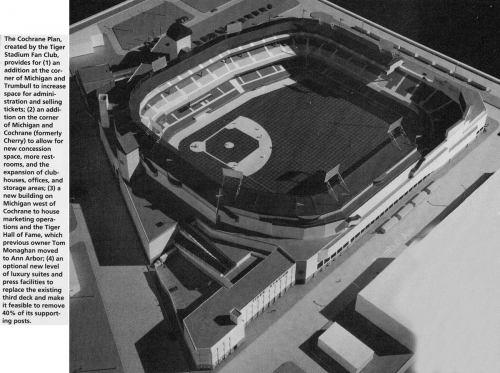
There’s a reason Comerica Park is not Tiger Stadium II. Sure it was fashionable to support Tiger Stadium, but the attendance numbers painted a different picture. The fans didn’t want to sit behind support columns and use dark 17 feet wide concourses. Yes, of course they should have cantilevered the upper deck of Comerica more for better field proximity, but it’s not too much worse than PNC Park. They needed a new ballpark to generate revenue. You think Tiger fans would have paid the prices Sox fans are paying now to compensate?
What’s most ironic is that Tiger management took noticeable steps to ensure that the fans were still close to the action, despite the “spread out” feel. A two deck design with no separate club level was requested early and a higher than usual percentage of seats are on the first level. In fact, the top row of the upper deck is only slightly higher than PNC Park.
But fans didn’t particularly care about any of that. They didn’t care about the gorgeous skyline view. They didn’t care that more time, money, and effort was spent on the exterior design than just about any other ballpark. They didn’t care that Comerica has more amenities than parks that opened more than 10 years later. They didn’t care about the unique yet subtle classic touches, such as the old fashioned moveable box seats. They didn’t care that Comerica had the highest proportion of comfortable seats. They didn’t care that Comerica brought an important seating innovation down the right field line. They didn’t care that officials took bold steps to maintain the egalitarian feel of Tiger Stadium. They didn’t care that Comerica Park is a shrine to Tigers history in a way that Tiger Stadium never was. So the national media didn’t really care to look either.
Built during the “gimmick boom” of the early 2000s, when understated ballparks were forgotten, Comerica went unrecognized for a while. But it provides a great ballpark experience. It opts for the quieter retro touches and packs a surplus of amenities into the park without being ostentatious.
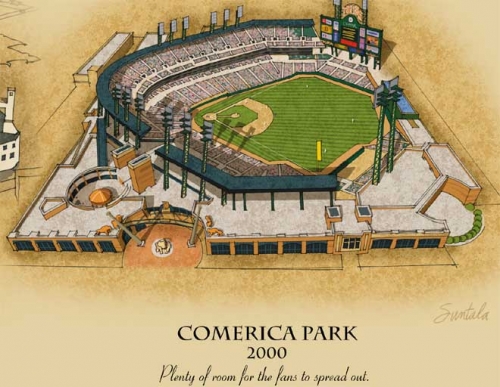
And 12 years later, people are beginning to realize it’s one of the more underrated in baseball. It really belongs in same category as the authentic retro parks like Camden, Progressive, and Coors. I talk ad nauseam about visually letting your city into the ballpark, and Comerica does that as well as any. It’s pretty simple, people. The truth is Comerica Park is intentionally understated to emulate the simple feel of Tiger Stadium, just with a 21st century sensibility. The problem is, with such an open and spacious feel, it lacks the cozy enclosure or intimacy of the Tigers’ former palace, and it is often labeled the anti-Tiger Stadium.
Perhaps the main point you should take away is, objectively, Comerica is unusually well-rounded in terms of amenities and functionality, succeeding in almost all aspects you could want. The concourses, restaurants, bars, social spaces, egalitarian premium seating model, more comfortable seats, new videoboard (2012), entertainment options, references to team history, and other amenities are all executed to perfection.
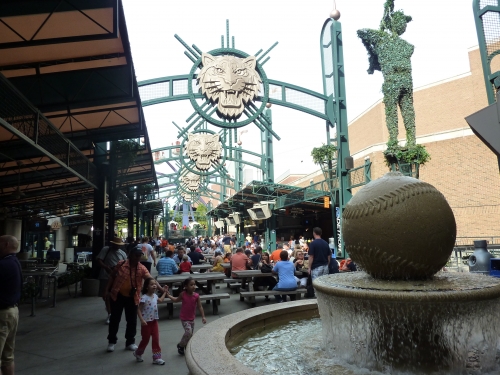
When asked what’s the best ballpark in the majors, I used to say (before Petco got better across the board) there’s really no perfect ballpark objectively. You can point out flaws in each. But Comerica Park is perhaps the least flawed ballpark in the majors under the 14 categories of objective criteria. Who knew? It’s fun to see how Comerica Park’s perception has evolved.
Looking at everything in the aggregate, Comerica does indeed complete for the top spot, which is sure to create a lot of controversy. I’ll talk more about this in the conclusion. With superior contextual integration and graceful interior lines, Comerica Park is good enough aesthetically, despite not surpassing PNC Park or AT&T Park. But Comerica is also unusually well rounded in all objective categories, unlike the aforementioned consensus jewels, meaning it will annually compete for the best ballpark in baseball.
Setting
Location/Access:
Parking can be a bit sketchy considering the options and the prices. You’re going to pay a premium for parking if you want to be safe. Owners are passing the security costs to the customer: $20 near the park and $10 within walking distance. If you don’t mind a 10-minute walk, it can get down to $5. I recommend the latter because it will give you a chance to explore a good part of downtown Detroit. Public transportation is not an option.
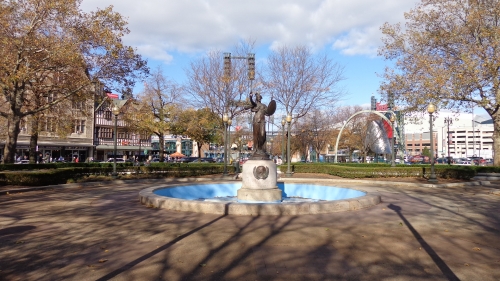
Yeah it’s Detroit, but the ballpark is in a good location. Yes, you have to watch where you walk, but would the suburbs have been better? The ballpark itself is nestled in the theatre district of Detroit, near attractions such the Fox Theatre, the Detroit Athletic Club, and Greektown. So I think Detroit does at well as possible.
Score: 4/5
Local Scene:
10 years ago, there wasn’t much going on directly outside the ballpark, but just a block down was hopping. Check out the Fox Theatre, the Athletic Club, and the Opera house. Definitely make sure to trek to Greektown a few blocks away. That’s where most of the action is located. The Hockeytown Café is probably the signature eatery/bar in the area.
I returned in 2012, and concluded that the local scene warranted a slight bump (with a slight downgrade in the food), and that isn’t just because of the World Series. The density of bars and restaurants in the area is more similar to something like Cleveland or Baltimore than Houston or St. Louis.
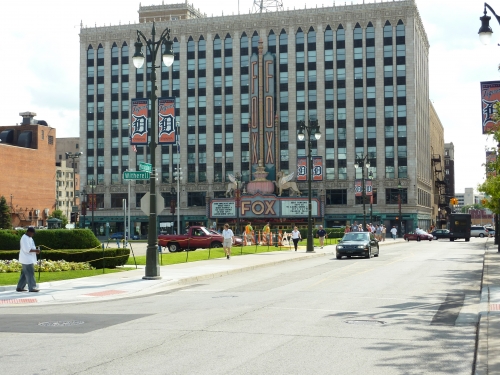

Score: 4.5/5
Total: 8.5/10
Architecture & Aesthetics
Exterior Design:
Comerica Park is a remarkably intimate building on the outside, possibly to a fault. Due to the sprawling design and the use of only two decks, the exterior appears sunken into the ground to the extent that the ballpark looks like a regular two story building. They went for the understated look, where the actual façade doesn’t attempt to overshadow the baseball experience, not considering the supplementary Tiger sculptures.
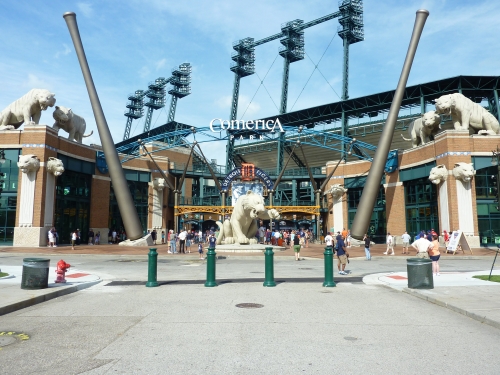
The physical plant of Comerica Park has a bit of a unique design. Surrounding “outbuildings” make up the façade, which are partially separated from the main seating bowl. This is why it basically looks like a one story building. The concept can be seen as a precursor to the design of Petco Park. It certainly shows the architects were coming up with new, innovative ideas, something that doesn’t seem true in ballpark design today.
Despite the definite lack of presence, and the use of the most generic red brick, the exterior is spectacular due to the life size Tigers lingering around. The “signature entrance” is one of the best in baseball.
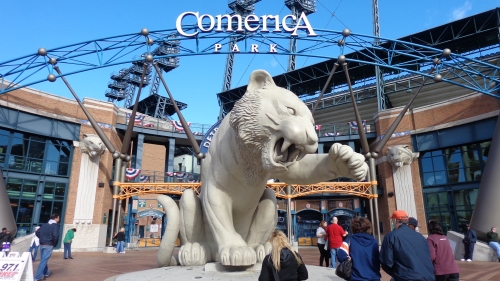
In contrast to a place like Angel Stadium, it would be inappropriate to claim these are gimmicks. Once you see the Tiger statues, you’ll realize these are real artistic sculptures. In fact, you could argue no other ballpark has more “art” on the exterior than Comerica. Designed by New York-based artist Michael Keropian, the ferocious statues guarding the entrances are done in immaculate detail. There are many of these creatures, and they are added in perfect proportion and rhythm.
The massive bats are modeled after the bats of different Tigers legends. Other various accents help as well, such as the tiger gargoyles on the walls. Take note of the tiger claw marks running down the white columns beneath with gargoyle heads. Throughout the design, we see blue and orange pewabic tile, a material native to Michigan. We have remarkable artistic attention to detail for a ballpark. This is Tiger Stadium.
I do get the sense that critics approach the park, like it, but conclude it’s too artificially thematic to be one of the best parks in baseball. Take a closer look.
Despite suffering from an especially architecturally unremarkable red brick design, perhaps intentionally, Comerica Park’s exterior is well-executed, despite reasonable accusations of being too thematic, supposedly lacking “true architectural merit.” These aspects prevent me from giving it an even higher score.
But at times, I get the impulse to grade this as one of the best ballpark exteriors in baseball, just because of the sheer time, money, and effort put into it.

Score: 7/10
Interior Aesthetics:
In comparison to other retro parks, one of the first things fans will notice is how seamlessly Comerica Park fits into the neighborhood. On the inside, perhaps only PNC Park did it better.
Comerica Park is primarily characterized by superior contextual integration, coupled with simple interior lines. I would call it intentionally minimalist and understated, unlike the other parks of the era. Comerica Park is retro without making a huge deal of it, complementing, not overpowering, the game on the field.
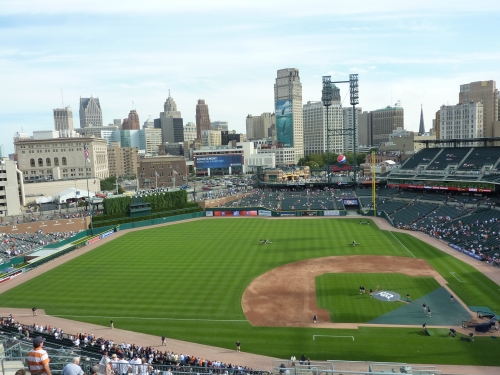
You have to look for the little touches in what is an underrated, no frills contextual design. Without any distinguishing features, Comerica generally falls into the camp of Citi Field, Busch Stadium, or Turner Field. What makes Comerica different (and better)?
Along with the obvious fact that it takes advantage of its setting, it’s confident in its architectural lines.
You see many of these more aesthetically undistinguished ballparks add gimmicks that really clutter the look in a false attempt to supplement the design. Comerica is confident in the simple look, while parks like Citi Field and Turner Field self-consciously clutter their outfield design with ads and gimmicks. Comerica has a clean, uncluttered outfield design that’s especially well connected to its context. There’s no disjointed feel here: the design is quite organic.
Again, what I love most about the outfield design is how is works well with the urban fabric of the city. Like AT&T Park in San Francisco, it’s one of the few new parks whose dimensions conform with regard to the surrounding streets. The facades conform to the property boundaries of Montcalm, Witherell, Adams, and Brush Streets. Even look at the left field corner, which subtly mimics the outside alignment. Note center field and the space beyond the center field structures.
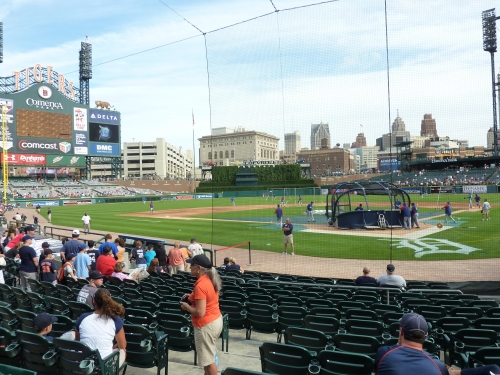
Other than PNC, only in Comerica can you see the skyscrapers towering over the field from the lower bowl because of the recessed outfield seating.
I think Comerica Park has more of a Wrigleyville look than any other ballpark in baseball. The area directly beyond the understated yet tastefully done brick “wall of fame” has the appearance of an old style neighborhood. You have the smaller buildings that appear a few feet from center field, with the Detroit skyline in the background. The cityscape itself isn’t equal to that of PNC or even Busch, but the integration is. It looks like the neighborhood is right on top of outfield.
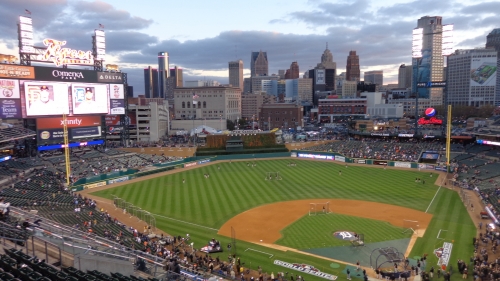
Note how the interior outfield lines converge inward toward the center field skyline, brilliantly emphasizing it, with the Detroit Athletic Club as the centerpiece. Now that’s perfect balance. Note the lack of any double decks in the outfield. The two-deck design in the outfield of other parks has become derivative and visually uninspiring. Detroit chose to avoid this in the interest of highlighting its surroundings. It sometimes feels spread out, but it really works.
While you don’t feel like the city is literally in the ballpark, like say in Cleveland or Minneapolis, Comerica Park feels extremely connected to Detroit, and not just in one spot, like Minnesota. The architects were confident in this look and took steps to highlight it. And really, that’s all you need for a great interior design, as long you don’t muddle it too much. Pretty simple. It’s astonishing how many other parks couldn’t get it right.
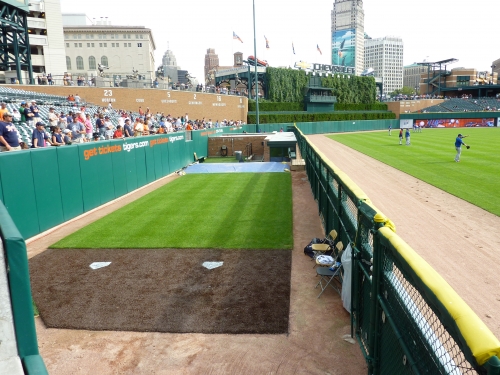
The massiveness of the scoreboard is juxtaposed with the rest of the understated interior quite nicely. Red brick is well integrated into the interior of the ballpark, as the “wall of fame” and the small scale of the batters eye carry out the “quiet retro” motif. Adorned with green ivy and a fountain at the top, Comerica Park has one of the nicer batters eyes in major league baseball, adding a small, appropriate amount of whim to a very simple structure.
I also appreciated that the Tigers integrated their historic references into the interior aesthetic schema. Located above the brick wall of fame, Comerica Park is the only ballpark where the team statues (discussed in historical references) have a prominent presence in the outfield.
If you are looking for originality, I might note that Comerica Park brought an important seating innovation to the table. Down the right field line, the upper deck discontinues from the main structure. This creates a gap in the grandstand down the lines, which breaks up the monotony of seats. In Detroit, the upper deck was brought closer to the action where the luxury boxes ended down the line, hence the need to break up the grandstand. Breaking the upper deck down the line naturally allows those seats to be oriented toward home plate, eliminating the awkward seats right before the natural point of reorientation. It could also be considered as a historical nod to the fragmented Griffith Stadium.
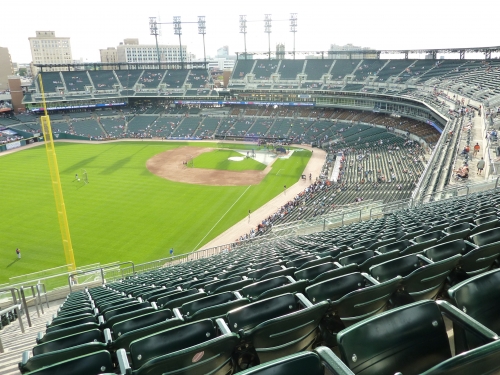
The subtle features aid the classic look as well. Like PNC Park, the two-deck infield grandstand is an unusual gesture. The dirt lining between the pitchers mound and home plate is unnecessary, but aids the “quiet retro” theme of the ballpark and works better here than anywhere else (Tiger Stadium had this in it’s early days). Also note the geometric home plate dirt design.
Despite being a bit on the less notable side in terms of distinctive features and originality, unlike some of the other jewels, I wouldn’t change much about the interior design: it’s a gem. Comerica is right there with Camden, Progressive, and Coors as “authentically retro.”
Like the former two, it benefits from having a simple contextually-based urban design, resisting the pressure to artificially muddle its architectural lines with gimmicks just to “be different”, which may be why Comerica is just now getting the credit it deserves. Paradoxically, by not artificially “being different,” with contrivances, Comerica is different from all others of its era, along with PNC Park.
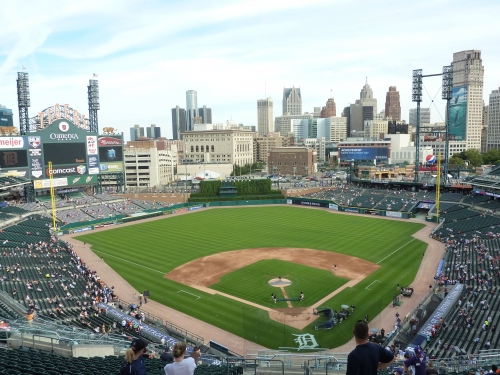
Score: 12.5/15
Panoramic View/Backdrop:
Again, Detroit’s backdrop is right up there with the best in baseball, because of the way they choose to integrate it into the overall design. The backdrop in itself is spectacular as well: five story buildings, highlighted by the Detroit Athletic Club, sprinkle the foreground, while the towering skyscrapers are in the background.
While it’s truly one of the best backdrops in baseball, I think most would agree its not on par with PNC or AT&T. But the setup is. You can see all of it from the lower level seating as the interior design really emphasizes it. The way the setting encompasses the ballpark is almost too good to be true. It’s similar to PNC’s design, which minimizes the outfield set up to allow the backdrop to standout. Once again, it has confidence in its understated design.
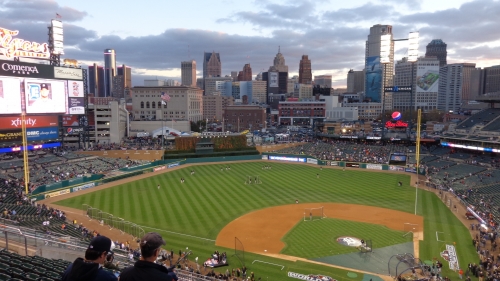
Score: 5/5
Concourse Aesthetics:
Comerica Park sports one of the most well designed main concourses in baseball, both aesthetically and functionally. The simplicity of the interior design is juxtaposed with the extravagant features and amenities that adorn the concourse. You’ll be taking pictures of the concourse at every corner. Don’t forget about the Ferris wheel and carousel. And despite the food court and other distractions, it doesn’t feel too much like a mall, but a festive baseball-oriented state fair.
Make sure to check out the Brushfire Grill, a patio area off the concourse. With its baseball fountain, ballplayer topiaries, and Tiger emblems, it’s unexpectedly gorgeous. I can’t believe I hadn’t seen a picture prior to visiting the ballpark.
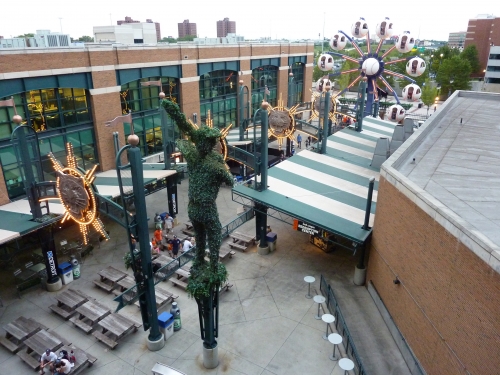
Score: 2.5/3
Total: 27/33
Functionality & Essentials
Sightlines:
The sightlines at Comerica Park are characterized by good proximity to the field due to the decking structure, despite being pushed back too far. The seating geometry is generally average.
Sightlines are generally good throughout the ballpark, with no significant obstructed view seating. I do feel like the seats down the lines could have been angled a bit more in some areas, but it’s generally fine. I’ve heard some substantial complaints regarding the seat angles, but it’s no Progressive Field. Unfortunately, there also appears to be more foul territory here, especially behind home plate, but its not significant.

Another legitimate criticism is that the spread out design results in a low, gentle slope in the lower deck. More than any other park, fans are likely to have blocked views if the fan in front of them is tall. But it’s a trade-off I guess.
The most common criticism regarding the sprawling seating design is the lack of overhang of the upper deck. While I certainly would have advocated the use of more aggressive cantilevers, the two-deck design inevitably places the fan pretty close to the action, in comparison to some of the newer ballparks. It could have been done better, but people are mostly wining because it’s not Tiger Stadium.
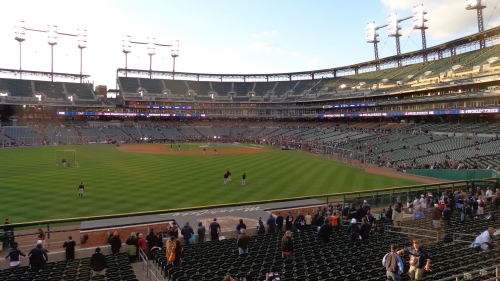
I also noticed an interesting tidbit from the upper deck in comparison to PNC Park. For back-to-back games, we had the exact same seats: row two in the lower upper deck. The view was virtually indistinguishable.
While PNC’s upper deck is lower, both ballparks have similar proximity to the action. The right field upper deck of Detroit, unencumbered by suites, is the closest in baseball. Comerica’s upper deck is in the same conversation with the notable intimacy of PNC’s. But you’d never know it based on the perception.
Score: 8/10
Seat Comfort:
The seats at Comerica certainly meet all of the standards and then some. Every seat, minus the bleachers, is equipped with cup holders. Compared to predecessors and peers in 2000, Comerica seems to have made overall comfort a higher priority.
Other than Busch and New Yankee Stadium, Comerica Park has the highest proportion of padded seats.
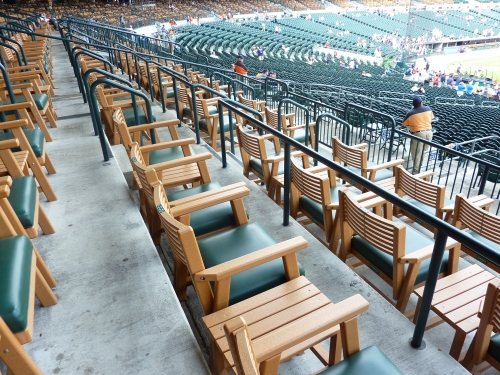
The Tiger Den consists of some of the most unique seats in baseball. While this is part of “premium seating,” the fact that 1000s of seats which would be thinly padded club seats in other ballparks look like this must be noted. As a side note, some of the Tiger Den seats were replaced in recent years down the lines with non-premium “terrace seats”. The stadium seats that replaced them are padded (theatre style) and have tables as well.
The lower part of the upper deck, labeled “club seats,” feature regular padded seats. These seats no longer come with any extra amenities. The fact that Comerica has the most comfortable seats in baseball puts them over the edge.
Score: 4.5/5
Concourses:
Comerica Park sports one of the most well designed main concourses in baseball, both aesthetically and functionally. In many ways, the park really benefits from having an expansive footprint.
Along with Safeco Field, you’ll note that it’s one of the first ballparks to have such an expansive selection of standing room areas. The concourse is open throughout the main level, and fans are invited to get out of their seats and watch the game from the “wall of fame”, the 416 New Amsterdam Bar, or other standing room areas. Walking around the infield, you never lose sight of the field either, unlike ballparks with press boxes or clubs blocking the view behind home plate.

You’ll also notice that the concourses are considerably wider than most ballparks throughout the majority of the lower level. Its minimum width (40 ft) is on par with the 2010 minimum standard for concourse width. So even 10 years later, it’s on par with new ballparks being built. It should be noted that they might get crowded in some areas, due to the large number of seats in the lower bowl. Comerica Park also benefits from great field visibility from the main concourse because of the high ceiling. Unlike some of the newer parks, the suite level is not enclosed, allowing for a more open feel.
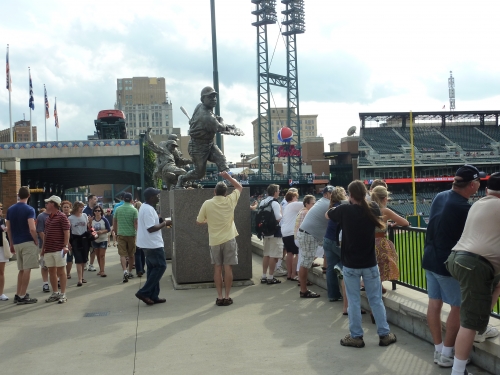
Note the brickwork of the suite level above, along with the green iron warehouse design. Note the walk of fame and the “decade bats”. You know where you are just based on the concourse. You’ll be taking pictures of the concourse at every corner. Don’t forget about the Ferris wheel and carousel. And despite the food court and other distractions, it doesn’t feel too much like a mall, but a festive baseball-oriented state fair.
Make sure to check out the Brushfire Grill, a patio area off the concourse. With its baseball fountain, ballplayer topiaries, and Tiger emblems, it’s unexpectedly gorgeous. I can’t believe I hadn’t seen a picture prior to visiting the ballpark.
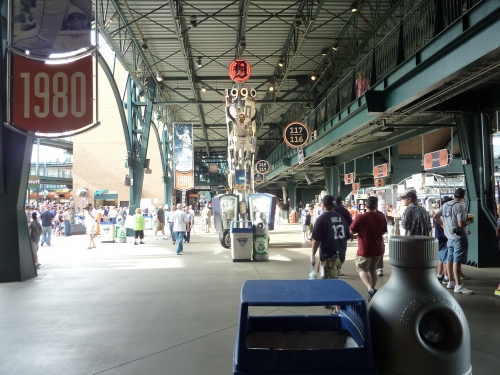
The upper deck concourse is also sufficiently wide, and closed from the field. If anything, Comerica Park’s Achilles’ heel is the narrowing of the concourse beyond the center field batters’ eye. Somewhat like Miller Park, the concourse momentarily contracts into a walkway here. This starkly contrasts with the “outfield experience” of many of the newer parks, and fails to promote proper circulation. I guess the spatial issues of downtown Detroit had to encumber the ballpark in some capacity.
Despite not quite reaching the brilliance of Safeco Field, nor meeting new standards, Comerica Park represented a major step forward in concourse design.
Score: 6/7
Scoreboard System:
Before 2012, Detroit had the weakest scoreboard system in terms of design, use, and quality. A medium sized matrix board and a small matrix board accompany the small sized video board. Not only was the system outdated, but it’s too cluttered as well. Like Cleveland, it was hard to distinguish the boards among so many ads.
Everything that the old one did wrong, the new one does right. No longer does it look cluttered, and they supply all the information anyone could need. Most significantly, the left side of the scoreboard is no longer obstructed for many fans down the line, as they now center the video system properly.
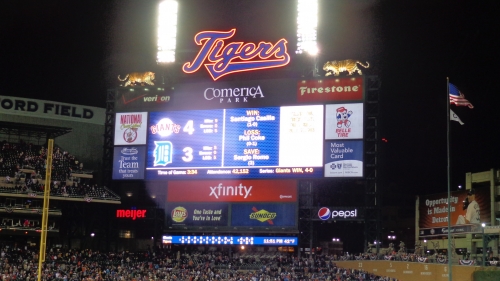
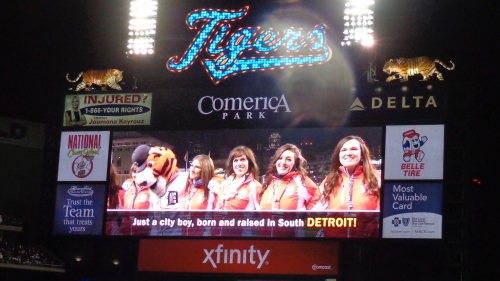
Score: 2.5/3
Total: 21/25
Amenities & Features
Quality and Selection of Concessions:
You never see Comerica Park on the list of best ballpark food, but that doesn’t prevent the Tigers from offering an above average food selection. That being said, the team has down scaled somewhat in recent years.
As of 2013, the food selection is reasonably varied, highlighted by significant Mexican and BBQ options, although the Asian food stand was replaced by a specialty burger stand. Subs are still an option in some form in the ballpark, specifically gyros. No seafood though. Considering its proximity of the Great Lakes, I would love to see some seafood offerings like Minnesota, but there just isn’t a market for it in Detroit.
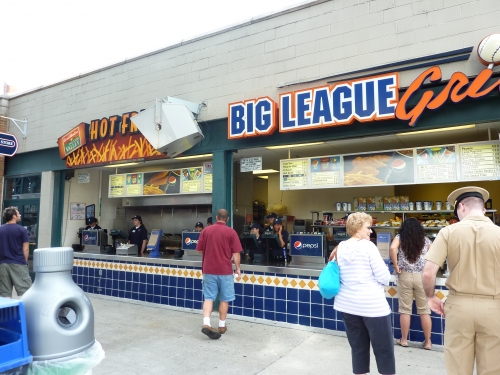
Unique offerings include, but aren’t limited to, apples with caramel, turkey legs, four flavors of Asian meat, Garlic fries, Egg Rolls, fajitas, wraps, international salads, local Coney dogs, Elephant ears (like funnel cakes), chicken pitas, and hummus platters. They have a nice selection of alcohol and daiquiris, highlighted by “jungle juice,” a nice allusion to the Tiger theme that will bring you back to your college days.
Many are quick to overlook Detroit’s undoubtedly impressive food selection, because they are not run by high quality local eateries and are presented under a bland, mall-like guise. The quality is not too far below par, and I tried the supposedly sketchiest options (teriyaki beef).
Comerica also has a plethora of Little Caesars stands scattered throughout the ballpark. So the pizza selection is more than most parks as well. They have great vegetarian options as well. Despite the good selection, as mentioned the quality is not as great, reflecting more of the mall-like feel. Comerica needs some food selections that reflect the local community, or at least are run by local eateries.
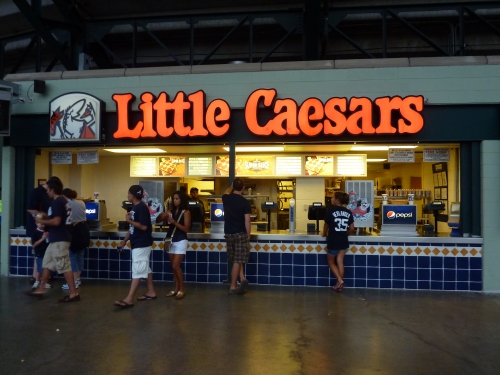
Look how well their neighbors in Minnesota and Milwaukee do in representing the region with local specialties. But that’s more in the signature food category. More importantly, they don’t meet the very high standard set by some of the other ballparks. But Comerica will surprise you.
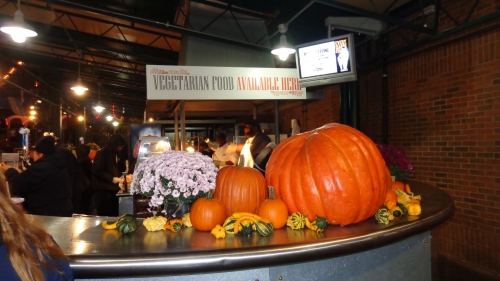
Score: 3.5/5
Regional/Signature Concession(s):
Again, I don’t really see one in Detroit. Where are the local food selections? Minnesota has everything you could want, including Murray Steak Sandwiches and Walleye fishes. Milwaukee has Wisconsin fish fry and multiple cheese specialties.
Perhaps there’s just not a market for anything too special in Detroit. One specialty is the Coney Dog, but that’s really just a hot dog with chili, onions, and cheese. I guess you could consider Little Caesars a staple of the area, but that’s a national chain. It has to be more unique than that. Hummus perhaps, for Greektown? In 2012, they took my advice and added a local burger stand, but that’s still too weak.

Score: 1/2
Public Restaurants/Bars/Sitting Areas:
Other than Petco Park, Comerica Park may have the most bars, restaurants, sitting areas, and social areas (that are open to all fans) in baseball. While lacking a true full-service restaurant with a field view open to all fans, Comerica Park is in the top 5 in baseball in this category. We have two quasi full-service restaurants (both renovated in the last couple years), a beerhall, an attractive picnic area, a new outfield bar, and a climate-controlled upper deck bar and lounge.
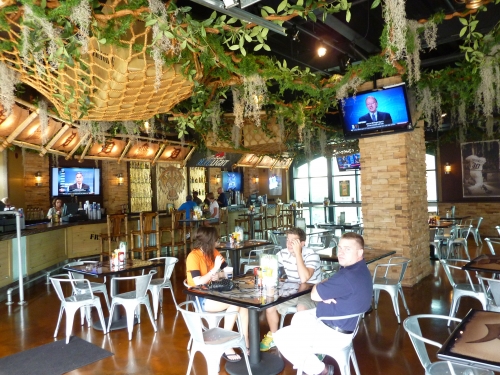
Formerly known as “The Jungle,” the newly rebranded Miller Lite Pitcher’s Pub is a sit down restaurant and bar in the right field mezzanine, formerly decorated in a natural bamboo, Amazon-like décor. This restaurant was pretty empty in 2010, and even more so after the new bar opened outside. So the Tigers are trying to rebrand this space and give it new life. On the main concourse, Comerica Park also features The Corner Tap Room, replacing Leo’s Coney Island. The sit down space features draft beer, food, and Tigers memorabilia. The eatery features a specialty menu with booths, traditional tables, and high-tops, along with outside tables along the street. It has been well received by fans.
Two slightly more informal places are of note. The Beer Hall is another enclosed sit down area, adjacent to the Tiger Den Lounge featuring the exact same menu.. So unless you want to see all areas of the ballpark, an extra VIP pass really isn’t necessary. The Brushfire Grill is the gorgeous picnic area previously described, adjacent to the Ferris wheel.
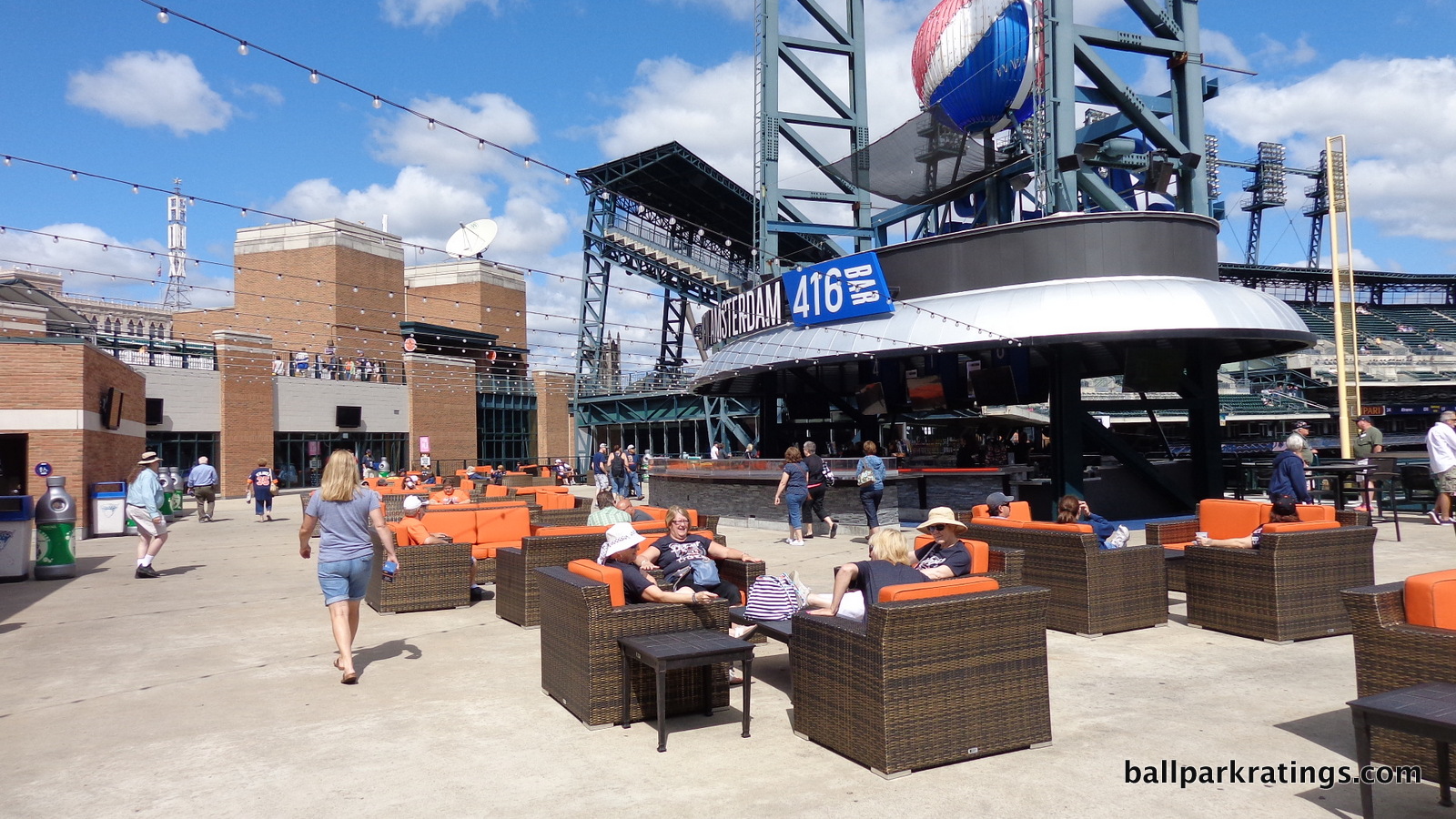
In 2014, the Tigers added the 416 New Amsterdam Bar in the right field mezzanine outside The Jungle. A true social space occupying a formerly unadorned area called the Pepsi Patio, the 416 New Amsterdam Bar features an expansive bar, attractive lights, and cushy orange patio seating. It’s the best place to hang out in the ballpark.
The upper deck lounge was originally a space designed for the “club seats” in the upper deck, but it’s now open to everyone. Only three other parks have climate-controlled upper deck bars or lounges open to regular fans, so this is an amenity I value greatly. In Detroit particularly, this is most welcome. Now called the Blue Moon Brewhouse, it is a true upscale space, featuring a bar, a separate sitting area, and its own restrooms. This is just another example of how Comerica Park really exceeds in offering fans every amenity they could ask for.
The Tigers really excel in this category, which I saw first hand during the 2012 World Series. Even on the busiest of days, fans can find a place to hang out or relax if they try.
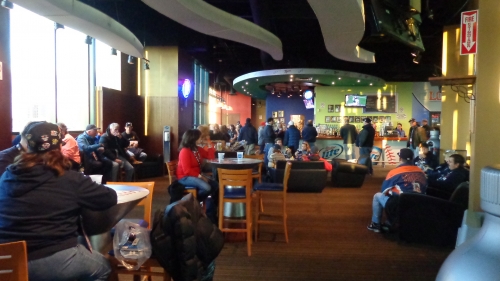
Score: 5/5
Premium Seating/Clubs:
Forget brick exteriors and cozy dimensions, Comerica Park goes retro in the premium seating category as well. Forget fancy club level concourses, Detroit wanted an intimate ballpark with a somewhat egalitarian look. Sure they have two levels of suites, but they don’t even attempt to dominate the interior. While I have positive things to say about this aspect of it, Comerica Park’s premium seating model is obsolete, lacking a true premium club space around the infield.
Comerica Park was the last ballpark conceived (Miller Park broke ground earlier, in 1996) without an ultra-premium home plate club, and the only ballpark built since 1989 without any sort of club on the mezzanine. There’s no getting around that. Baseball traditionalists, who sometimes deride Comerica Park for some reason, should be applauding.

Instead, they relied on a heavy inventory of luxury suites and a club restaurant, the former of which is not conducive to the market today, while the latter concept is generally not implemented in most 21st century ballparks. Although the lower part of the upper deck originally had exclusive lounge access, it is not a premium space today. The lack of club seating does bring the upper deck closer to the field, but the overall premium seating is lacking compared to others.
That being said, I think the Tigers do about as well as they could here given these facts. With no separate club level behind home plate or on the mezzanine, Detroit got creative. They came up with something that’s conducive to their fan base and is also authentically retro.
At the back of the lower bowl, Comerica Park has old fashion moveable padded deck chairs with end tables known as the Tiger Den seats (seen in “Seats”). Easily the most comfortable seats in the majors in terms of foot room and width, this fits their demographics quite well. Consider a substantial part of their fan base: elderly people.
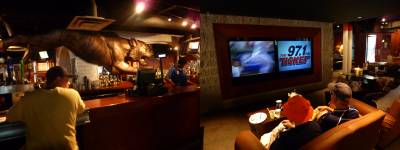
Throughout the late 80’s and 90’s, Detroit’s diminishing socio-economic conditions, along with the team’s consistent failure, led to few new, younger fans. Polls indicated that Detroit’s fan base was considerably older than most. These seats provided excellent shade, accessibility, and ample space for the elderly suburban fan base.
The seats are indeed very spacious and are their meant to be sold in groups of 4 or 6, so these innovative boxes could be seen as precursors to the loge boxes of today. The end table can be moved in front of you for eating. They also feature in-seat service. It’s not really like exclusive club seating though, as seating integrity can be regularly compromised by non-ticketed fans. They are relatively private though, with the aisles separated from those leading to the regular seats below.
Fans sitting in the Tiger Den or the On-Deck Circle have access to the Tiger Den lounge, along with the Tiger Club. On-Deck Circle seating (not padded) consists of the first rows of the lower seats from dugout to dugout. The Tiger Den lounge is probably due for a renovation, as it lacks much of the expected qualities of a premium club space. Highlights include the striking entrances doors, the lunging Tiger above the bar, and the lounge seating in front of the big screen TV. One red flag is that you don’t get an upgrade in food selection, as it has the same exact menu as the Beer Hall next door. But there is a neat level of innovation to the Tiger Den box concept.
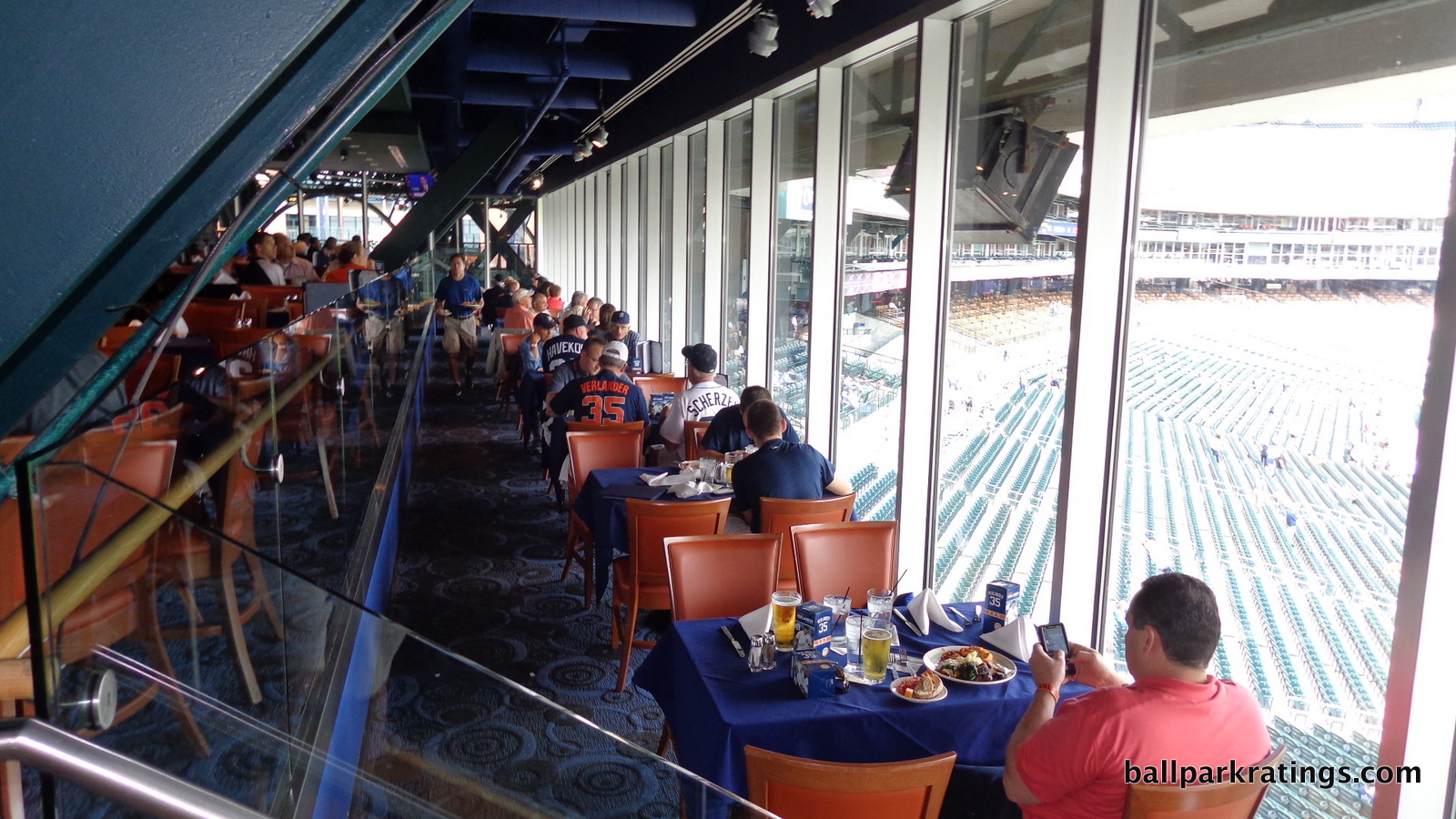
The Tiger Club, open to members and those in the Tiger Den/On Deck-Circle seating, is one of the nicer club restaurants in baseball. Designed with numerous Tiger accents and references to team history, it’s a must see. The biggest perk is access to the Cigar Bar within the Tiger Club. Members get their own private humidors. It is one of two cigar bars in major league baseball (the other is in Tropicana Field).
The Tigers also offer one of those hybrid “suite/club” experiences that are becoming more popular due to the decreased demand in luxury suites: the Champions Club. This is the only true club space in Comerica Park. In a small, all-inclusive space on the suite level, fans get to view championship trophies and other memorabilia. The location down the left field line is not ideal, as it’s in a location where the Tigers couldn’t sell luxury suites.
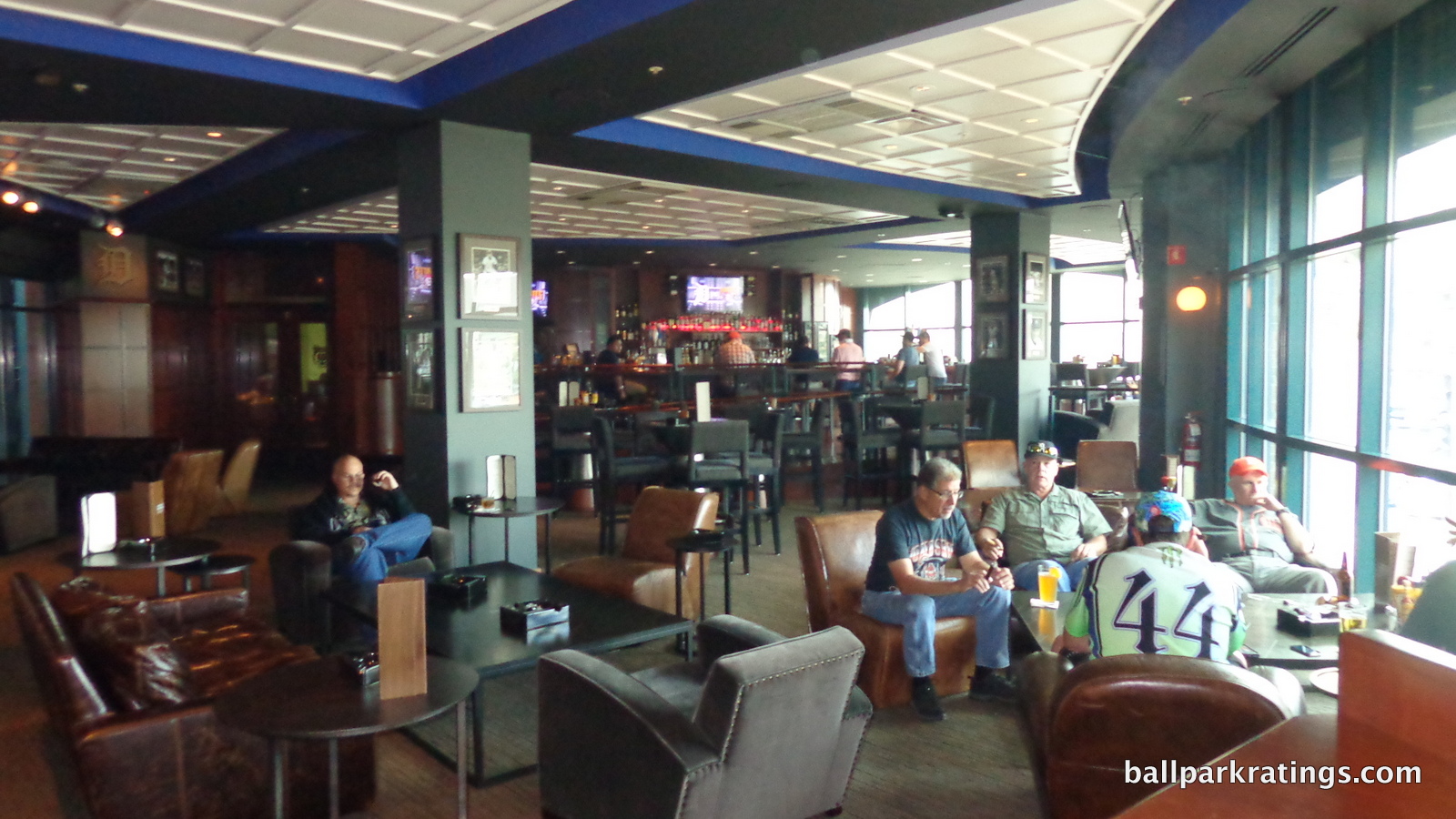
With thoughtfulness and innovation, Comerica does about as well as it could in this category, but there’s no ignoring the shortcomings. With all the wining about exclusive “moats” and clubs, I find it funny how everyone overlooks this fact about Comerica when you think they’d be applauded. It’s an obvious effort to avoid the usual degree of separation seen in other new ballparks and emulate Tiger Stadium.
Score: 3.5/5
General or Artistic References to Baseball or Team History/Museums:
Forget about stashing your team’s history in exclusive clubs and museums, the Tigers bring it out to the people. The concourse is the museum. Comerica Park itself is the museum!
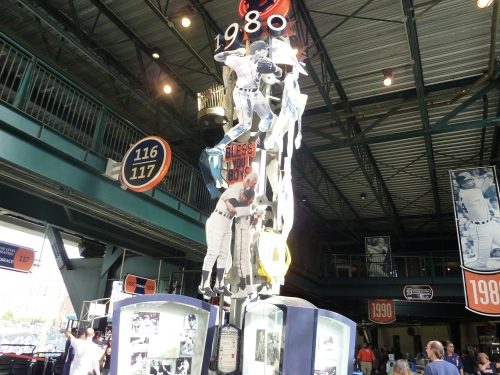
Throughout the main concourse, Comerica features a prominent historical display known as the “walk of fame”. From the 1890s to the 1990s, the “decade bats” signify each era in Detroit history.
Numerous display cases, pictures, and artifacts adorn each decade bat. Some say it has a cluttered look, but it is a wonderfully original gesture, informing even the casual fan of the historical nature of Tiger baseball.
Comerica Park was the first park to integrate history into the fabric of the ballpark, as most historically endowed teams just feature museums or plaque areas. The team plans to continue the history for each decade on the upper deck. In my opinion, the Tigers deserve profuse credit for this.
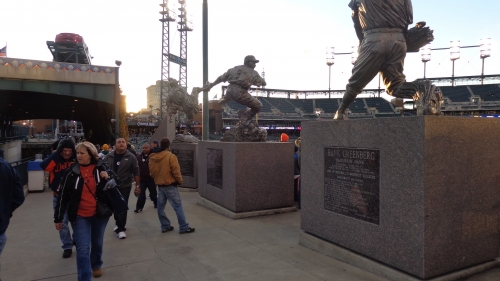
Another standout feature is the six statues in the outfield. There is a certain dynamic life-like element to these players not seen in other sculptures around the majors. They really capture the heart of each ballplayer. Ty Cobb, Charlie Gehringer, Hank Greenberg, Al Kaline, Hal Newhouser, and Willie Horton are all featured with corresponding information written on the base.
Like the walk of fame, I appreciate that these statues are so prominently presented in the ballpark.
Cool memorabilia and pictures are also featured in the numerous lounge areas, including the Tiger Club and Tiger Den Lounge. Specifically note the photograph of Ty Cobb with an eye patch in the Tiger Den Lounge!
Score: 5/5
Entertainment/Kids Activities/Other Amenities:
Tiger management certainly chose to offer a bevy of distracting entertainment activities for fans not immersed in the game. I tend to look positively on these features, as they remain tastefully presented in a Tiger theme and show an effort to go the extra mile.

For traditionalists, management sought to separate them from the structure as much as possible. Again, it’s interesting to note the juxtaposition with the simple outfield design, clearly articulating the architect’s intentions: build a classic understated ballpark, while tastefully integrating amenities. This isn’t Turner Field. While there are distractions for adults as well, the Tigers have two features that cater to kids unlike any place else.
The ornate carousel, located in the food court, is brilliantly sculpted with 30 hand-painted tigers, not horses. We have surprisingly great attention to detail here, in an era where standardization is ubiquitous under the guise of retro. They also have the infamous Ferris wheel at the end of the Brushfire Girl, adorned with 12 baseball-shaped cars. Both are done in a Tigers baseball theme and add to the aesthetic appeal of the ballpark. They fit in well, while not distracting from the game if you don’t want it to.
Traditional kids activities, such as speed pitch, are located in the outfield.

Score: 3/3
Total: 21/25
Atmosphere, Vibe, & Policies
Atmosphere/Fan Support:
Detroit is truly one of the better baseball towns in America. Terrible teams in the 90’s invited people to group Detroit with classic baseball towns like Cincinnati and Pittsburgh instead of St. Louis and Chicago. The truth is, Detroit is somewhere in the middle.
It certainly doesn’t belong with the former, but economic factors will never allow the Tigers to consistently draw as many fans as the latter. Throughout the next 10 years, they can continue to draw 30,000 plus however, despite continuing economic problems. Nonetheless, Tiger fans are in the upper echelon in terms of fan knowledge, with an electric atmosphere when the park is full.
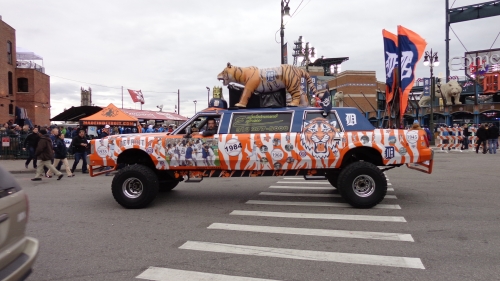
Score: 3.5/5
Ballpark Policies/Customer Service:
You aren’t going to have any problems freely exploring the ballpark in Detroit. I saw no problems with the ushers. It doesn’t get as much publicity as AT&T Park’s free views through the archways in right field, but Comerica Park has something similar. Fans without a ticket can view the game through the fences on Adams Ave. Awesome!
Score: 2/2
Bonus:
For being the standard barer of how ballparks without gimmicks and distinguishing features can still be aesthetically pleasing if they are confident in the design and brilliantly integrated into the context +2
For the Tiger statues guarding the exterior, along with other brilliant artistic accents +1
For the best entrance in baseball, giving fans an unmistakable sense of arrival +1
For packing numerous amenities and lounges into the structure in a tasteful and non-invasive way, in what is one of the least economically divided and more egalitarian seating arrangements +1
For integrating history into the fabric of the ballpark unlike any other +1
For the intimate two deck design and being the first ballpark to break seating down the line (Comerica pioneered this) to improve sightlines +1
Score: 7
Total: 12.5
Conclusion
Comerica Park scores surprisingly high in our ballpark ratings. It seems the best ballparks in baseball are falling in the middle of the ballpark building boom, before architecture became soulless and streamlined, but after the early retro gems that lacked in amenities. Comerica Park was initially overshadowed because it opened along side two very innovative parks in 2000, and because it replaced the classic Tiger Stadium.
When you look at the objective measures, Comerica almost scores high across the board. The amenities are extensive but most importantly tasteful. It’s maybe the most fan friendly park in baseball, other than perhaps Safeco Field and Citizens Bank Park. But unlike the former, its aesthetics are outstanding, and unlike the latter, it has a downtown location as well. Comerica is the complete package. For those Tiger Stadium fans, the lack of overhang in the upper decks isn’t worse than your average retro ballpark, while being lower to the field. So that claim is factually false.
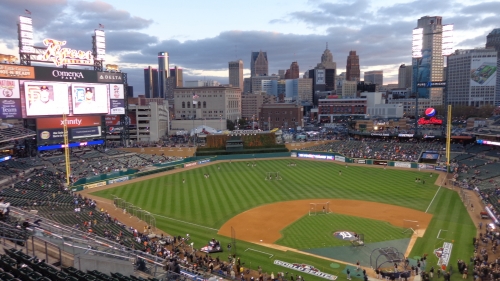
Still, I had to pause when I saw it rated this high. It’s hard to get past preconceived notions. I couldn’t believe that Comerica Park ended up scoring near the highest in the ballpark rankings.
I proceeded to further analyze the ratings of this park, along with more highly acclaimed parks like AT&T Park and PNC Park, thinking this can’t be true. But I just couldn’t justify changing anything. AT&T Park has objective flaws such as the seating angles and the narrow concourses, and I even gave it a staggering 10 subjective bonus points (Comerica gets 7). A similar story applies to PNC Park in other objective flaws. Camden Yards also has a number of similar objective flaws. Only Petco in San Diego, which really evolved into the complete package during the 2010s to a stunning degree, so clear tops Detroit’s (any everyone’s) jewel.
While not being aesthetically transcendental like parks in Pittsburgh, San Francisco, and Baltimore, Comerica Park is almost objectively flawless, while being good enough in aesthetics and location.

How? Well let’s sum it up. Comerica Park has a vibrant local scene in downtown Detroit, even if it is Detroit. The new District Detroit should make things even better.
The intimate and understated exterior and interior aesthetics couldn’t possibly be construed as anything other than above average, despite any subjective criticism.
The ballpark has thousands of more comfortable seats than most ballparks. In the interest of intimacy and quality sightlines, Comerica Park has the lowest upper deck other than PNC Park, contrary to the myth that Comerica Park is too “spread out.” The concourses are wide and open to the playing field. The videoboard is one of the largest in baseball.
In terms of amenities, the ballpark has a fantastic number of sit-down areas, restaurants, bars, and social spaces, way beyond most stadiums in baseball. The Brushfire Grill; The Corner Taproom; A Beer Hall; The Miller Lite Pitcher’s Pub; The New Amsterdam 416 Bar; an upper deck lounge (a rarity in baseball) called the Blue Moon Brewhouse; and even a Cigar Bar! (along with multiple premium options such as the Tiger Den and Tiger Club).
The entertainment options such as the carousel and the ferris wheel are wonderfully delightful and over the top, but most importantly for the traditionalists, relegated to the outskirts of the ballpark. Even the premium seating options are tastefully done, sporting an egalitarian look that doesn’t attempt to divide the ballpark, as opposed to the “moats” of today.
Most of all, a deep sense of baseball history is integrated into all aspects of the ballpark, highlighted by the decade bats and the outfield statues. Walking around the main concourse, you realize Comerica Park itself is a shrine to Tigers’ history. Instead of building a museum in the ballpark, the ballpark itself is the museum. I love ballparks that showcase a team’s history, and the more I think about it, this is by far Comerica’s most underrated quality.
None of the ballparks mentioned above can compete with this complete package.

There just isn’t much to criticize here. I’m proud to proclaim this is a truly outstanding ballpark. I know I’m droning on, but I do so because this is a controversial claim, one I’m trying to back up as extensively as possible: Detroit will annually compete for the best ballpark in baseball (not counting Wrigley and Fenway, obviously). Mike Ilitch and the Tigers built a palace that accommodates all fans and excels in nearly every category. As no one else has scrutinized ballparks like this and objectively rated them in such a comprehensive and systematic manner, I hope this revelation gets attention. Because no one ever claims Comerica is the best in baseball. But I think those who truly follow ballparks, like those at Baseball Fever or Ballpark e-guides, know it’s not that much of a stretch.
FINAL SCORE: 89
RANKING: #7/30
Summary
TL;DR? Here’s the long-form piece in a nutshell:
My take on Detroit’s ballpark is the site’s most controversial (in its prime, I had it as high as #3), one of the few times where I sharply deviate from the consensus.
Suffering by comparison to the venerated Tiger Stadium, Comerica Park generally hasn’t received the praise of other 21st century ballparks. Comerica is also hindered by its association with the poverty of Downtown Detroit and sightline complaints, both of which are misunderstood or overblown. Most ballpark aficionados rank Comerica in the middle of the pack.
Assessing Comerica on its own merits in the context of its post-1990 peers and not to the all-time great Tiger Stadium, I think it’s by far the most underrated active ballpark in MLB. It could shoot up to top-5 status again with some, admittedly, much needed renovations.
A downtown locale with surrounding bars and restaurants? Check. Marvelously expansive exterior monuments? Check. Understated interior aesthetics with the best ballpark skyline views outside of Pittsburgh and St. Louis? Check. The lowest upper deck of the newer parks outside of Pittsburgh? Check. Wide, open concourses with a panoply of accessible destination restaurants, taprooms, beer halls, and lounges? Check and Check. Historical memorabilia and statues adeptly interwoven throughout the concourses, but with frivolous kids-friendly attractions like the Ferris Wheel and Carousel relegated to the outskirts. Check and Check.
1) Decent downtown locale, 2) Gorgeous aesthetics inside and out, 3) Supremely functional, and 4) Filled with fan-friendly amenities. Very well rounded.
Of course, a ballpark is more than the sum of its parts, and the through line creating that necessary “wow factor” is just how elaborately Comerica represents its tenant.
Tiger sculptures, gargoyles, and claw marks outside. View of Downtown Detroit and the Wall of Fame from anywhere inside. A team “walking museum” and player statues throughout the concourses. Tigers embroidered on the doors; Tiger sculptures above the bars. Close your eyes, step almost anywhere in or outside the ballpark, open them, and you’ll see something that screams “Detroit!” or “Detroit Tigers!”
Strong sense of place here, as everything shrewdly incorporates elements of the city and the franchise.
Comerica Park is not flawless, of course. The concession stand food needs improvement. The incline of the lower bowl is too gentle, but that’s a common problem of ballparks of this era, making it odd to see Comerica always singled out in this respect. Many of the interior spaces badly need a renovation, and renovations are needed in general, hence my downgrade. It is beginning to really show its age. And day games are no fun in certain spots with the blinding sun, a function of Comerica’s south-ish orientation.
But overall, it still seems like fans who are inclined to opine on their Comerica Park experiences downplay its many assets and exaggerate its few shortcomings. They probably just miss Tiger Stadium. Fair enough!
Defining Features
Tiger Sculptures
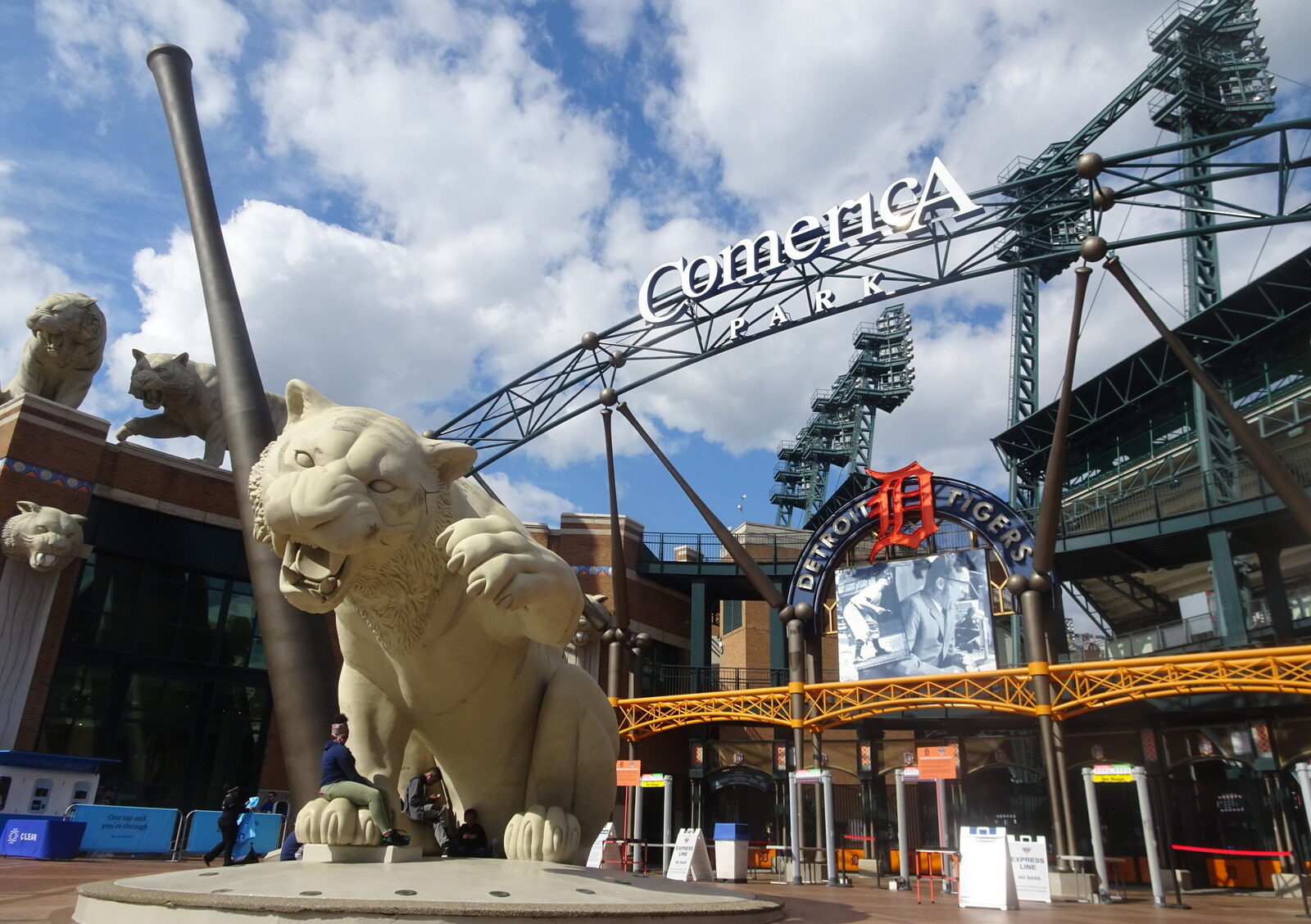
Fountain
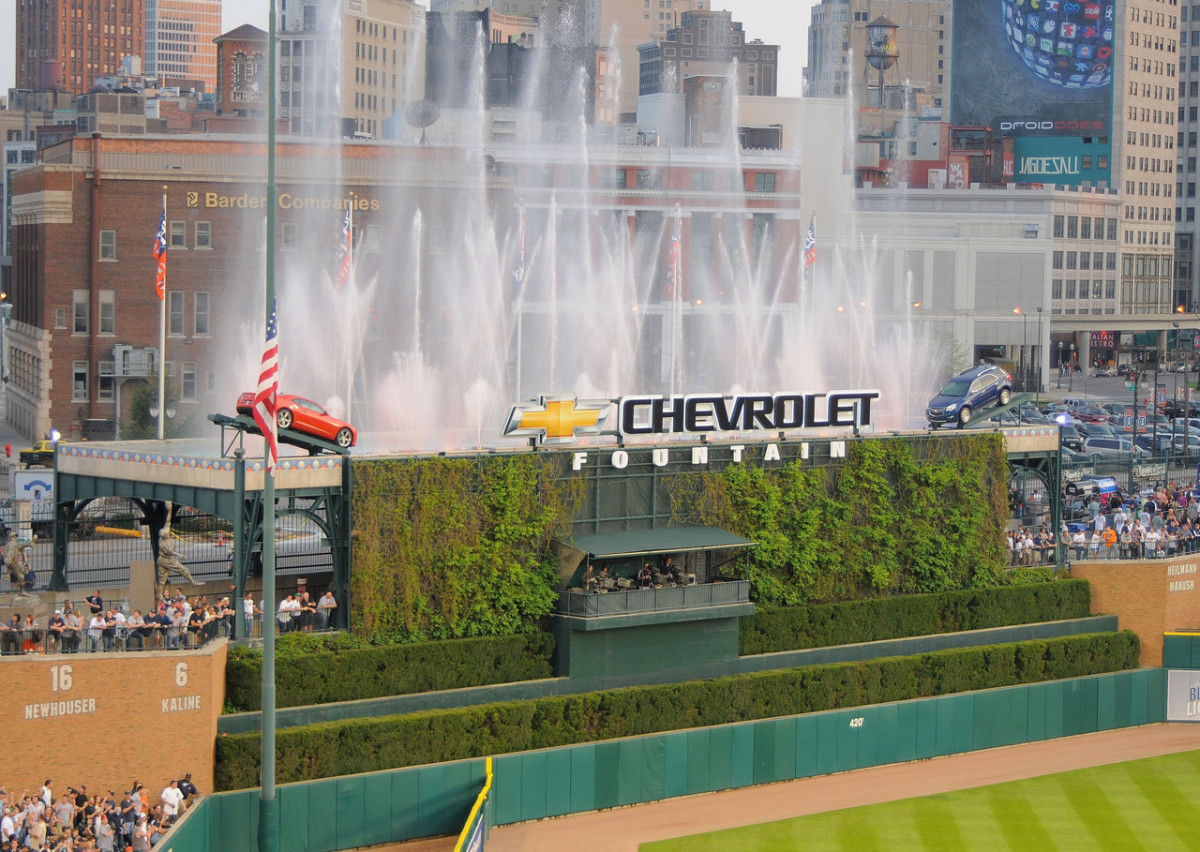
Biggest Hit
Ballpark Reflects Detroit Tigers and/or City of Detroit in All Facets
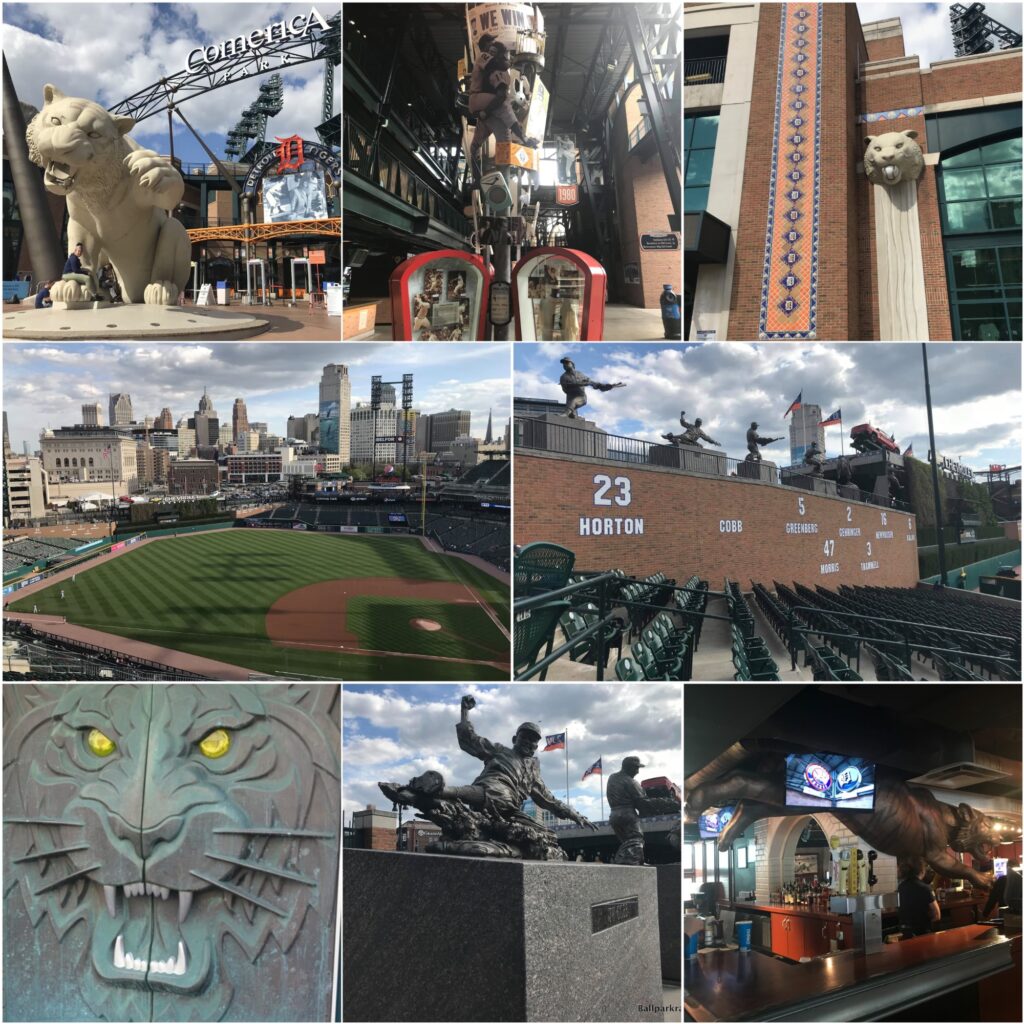
Biggest Miss
Gentle Incline of the Lower Bowl; Lower Bowl is Too Large
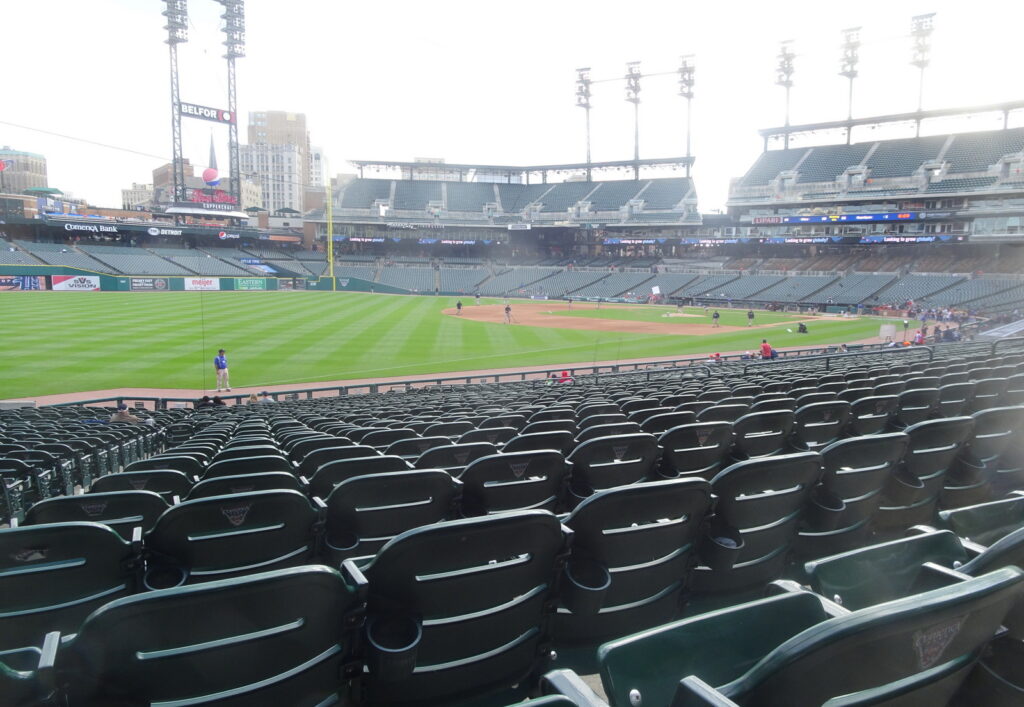
Other Hits
Skyline Views
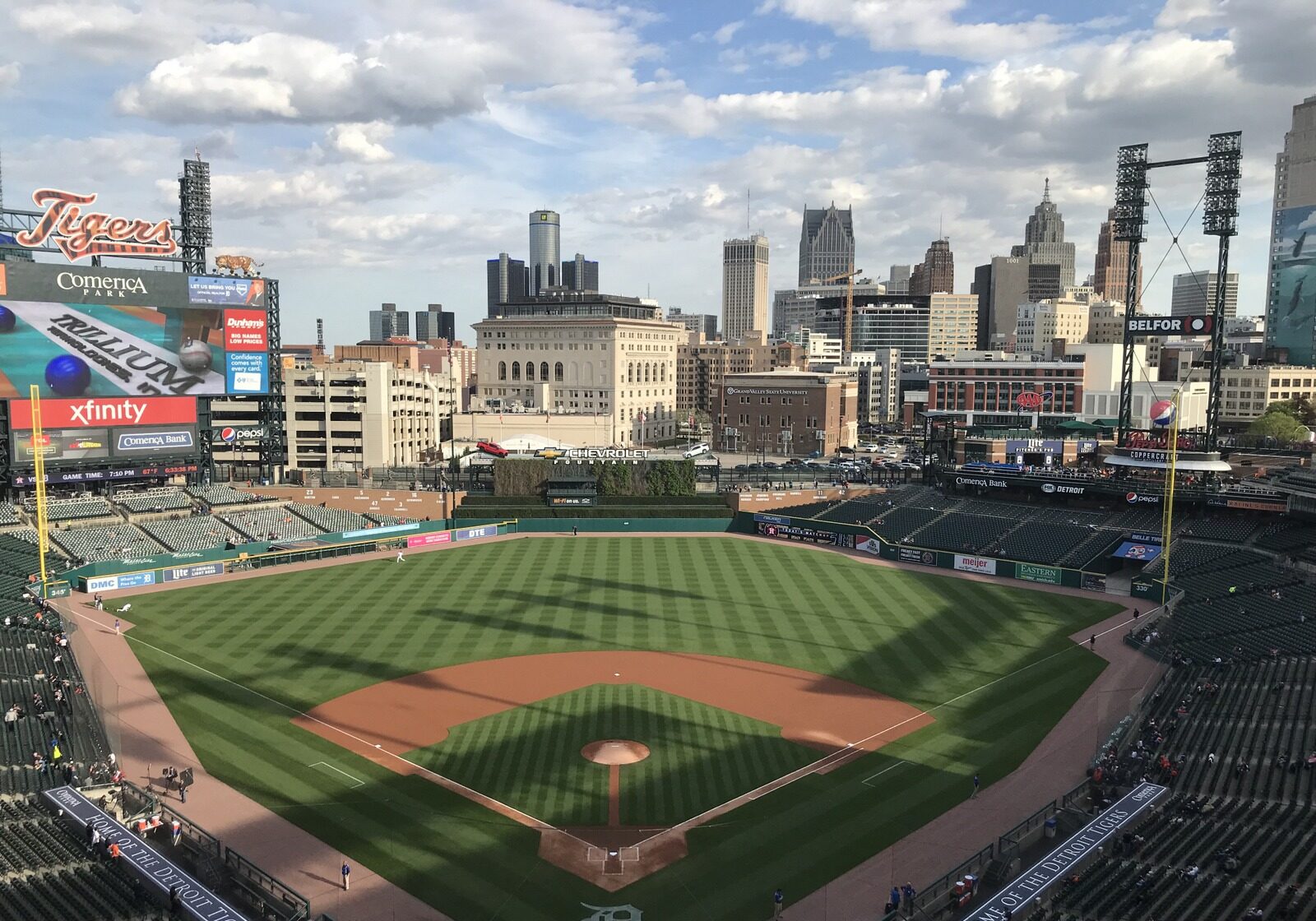
Exterior Tiger Sculptures and Other Flourishes
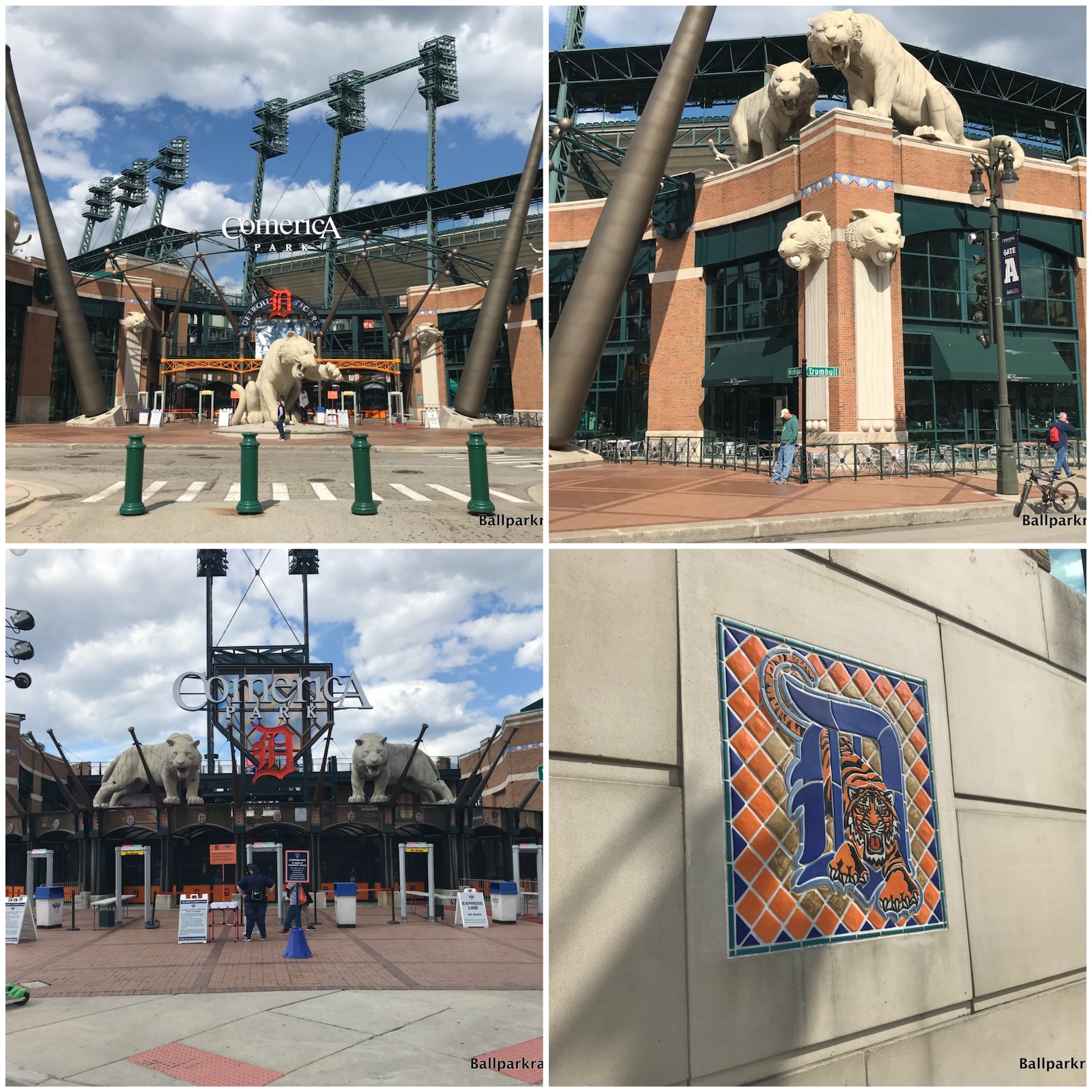
Beautiful Exterior Scene Independent of the Sculptures

MLB's Best Statues and Wall of Fame

Uncomplicated Interior Aesthetic Free from Contrivances or Gimmicks

Attractive Batter's Eye

Relatively Low Upper Deck by Virtue of No Mezzanine Club Level
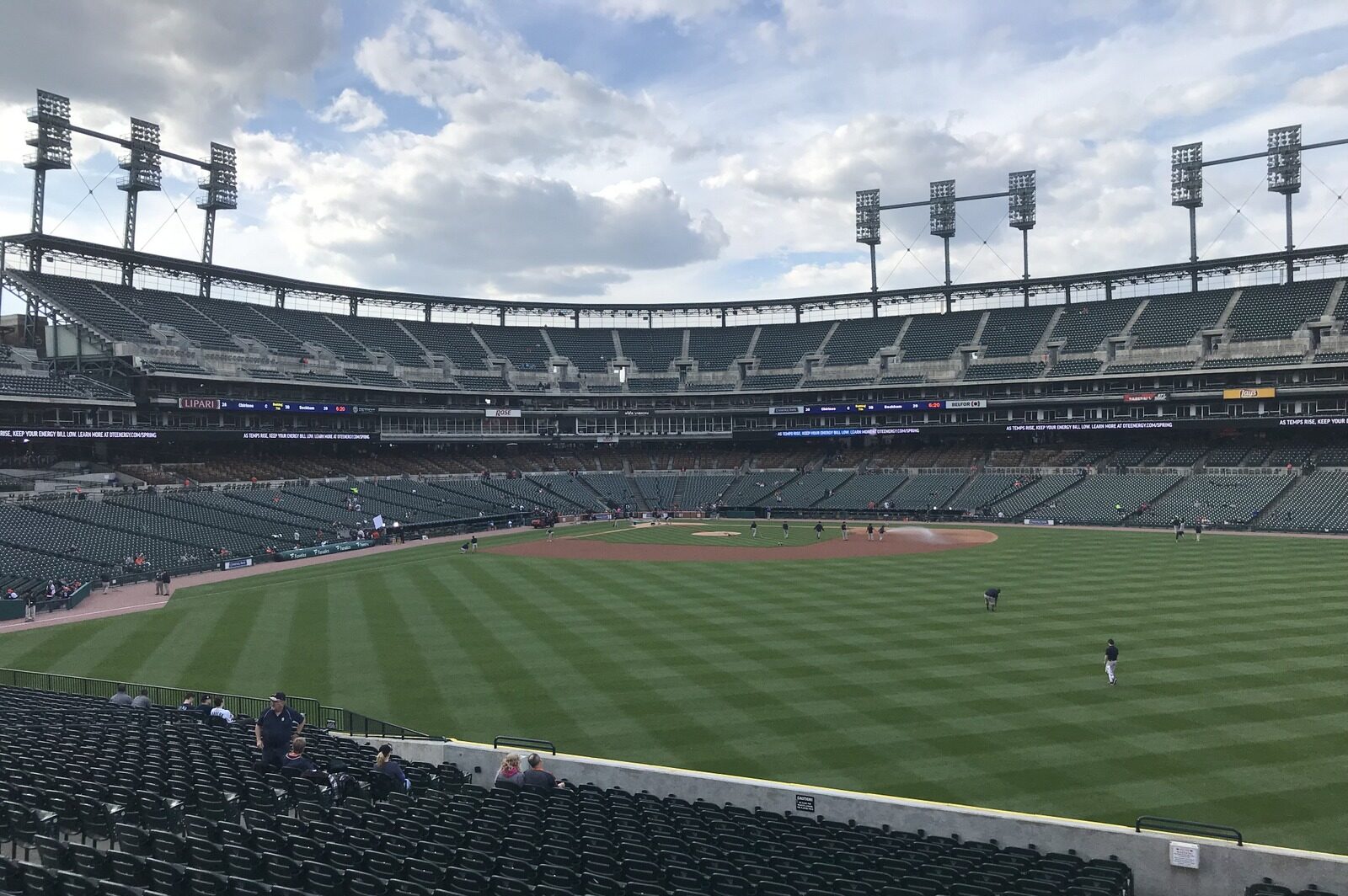
Walking Museum

Wide, Easily Navigable Main Concourse Totally Open To The Field
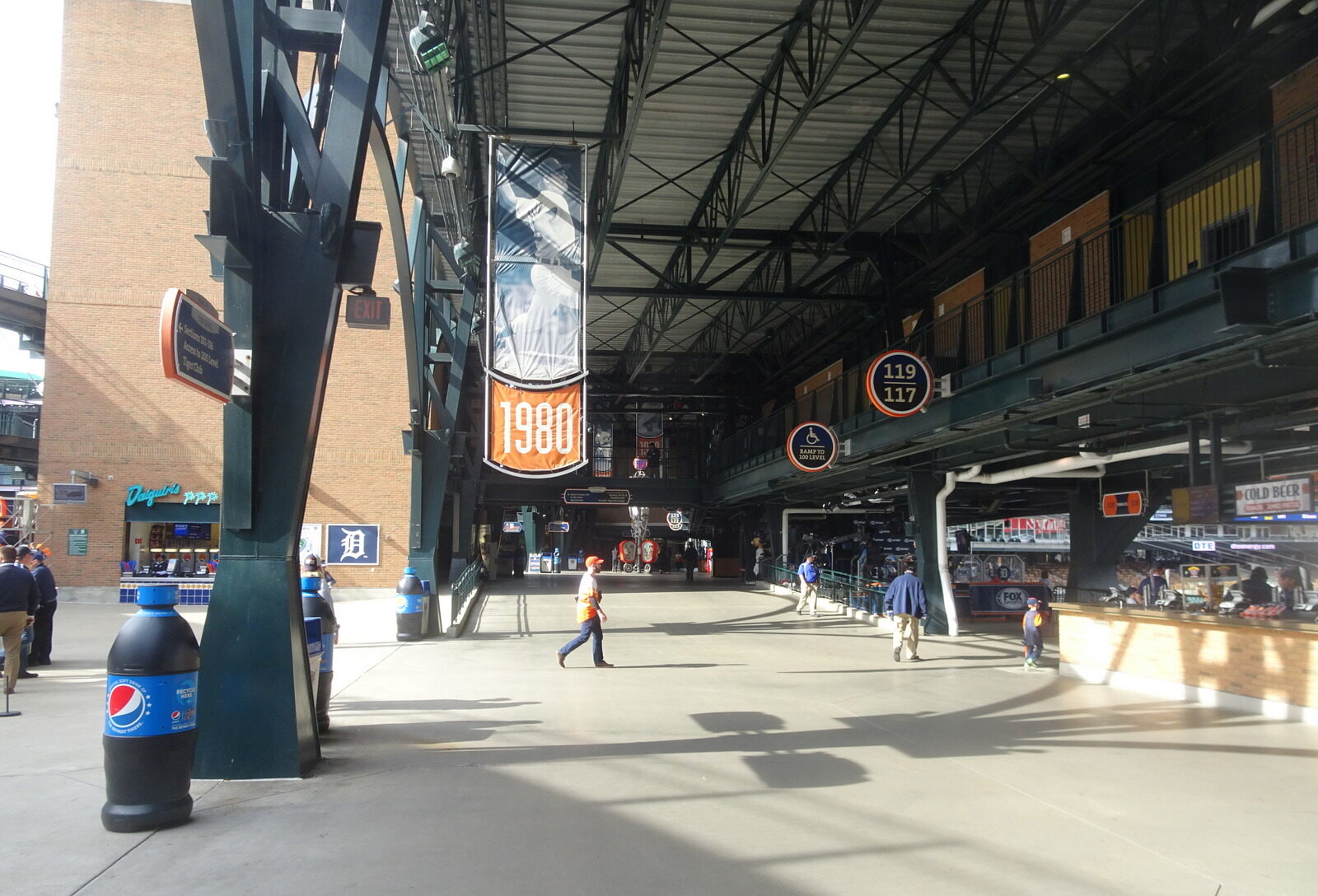
Aesthetically Gorgeous Concourse Spaces, Particularly the Brushfire Grill
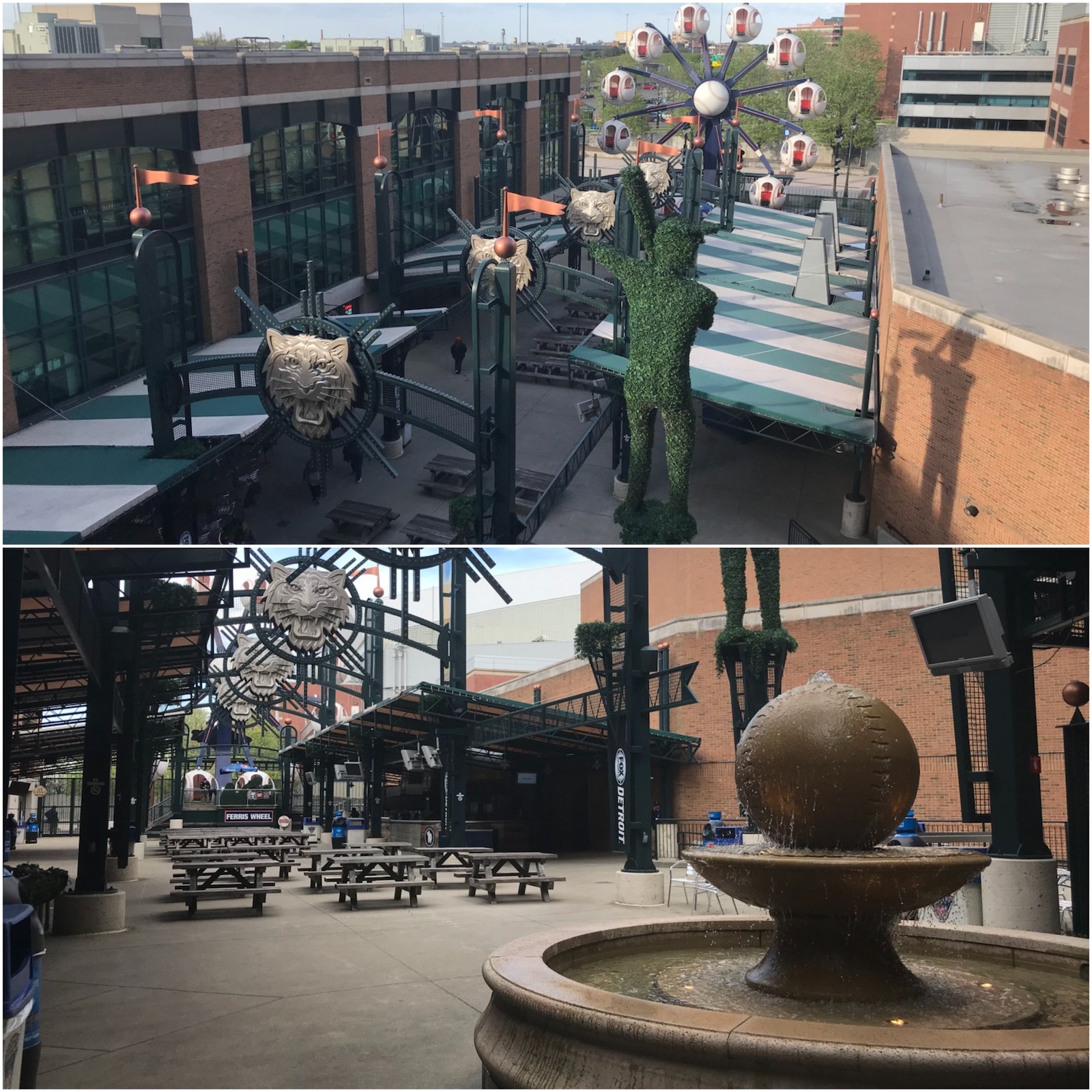
Solid Standing-Room Only Areas in the Outfield
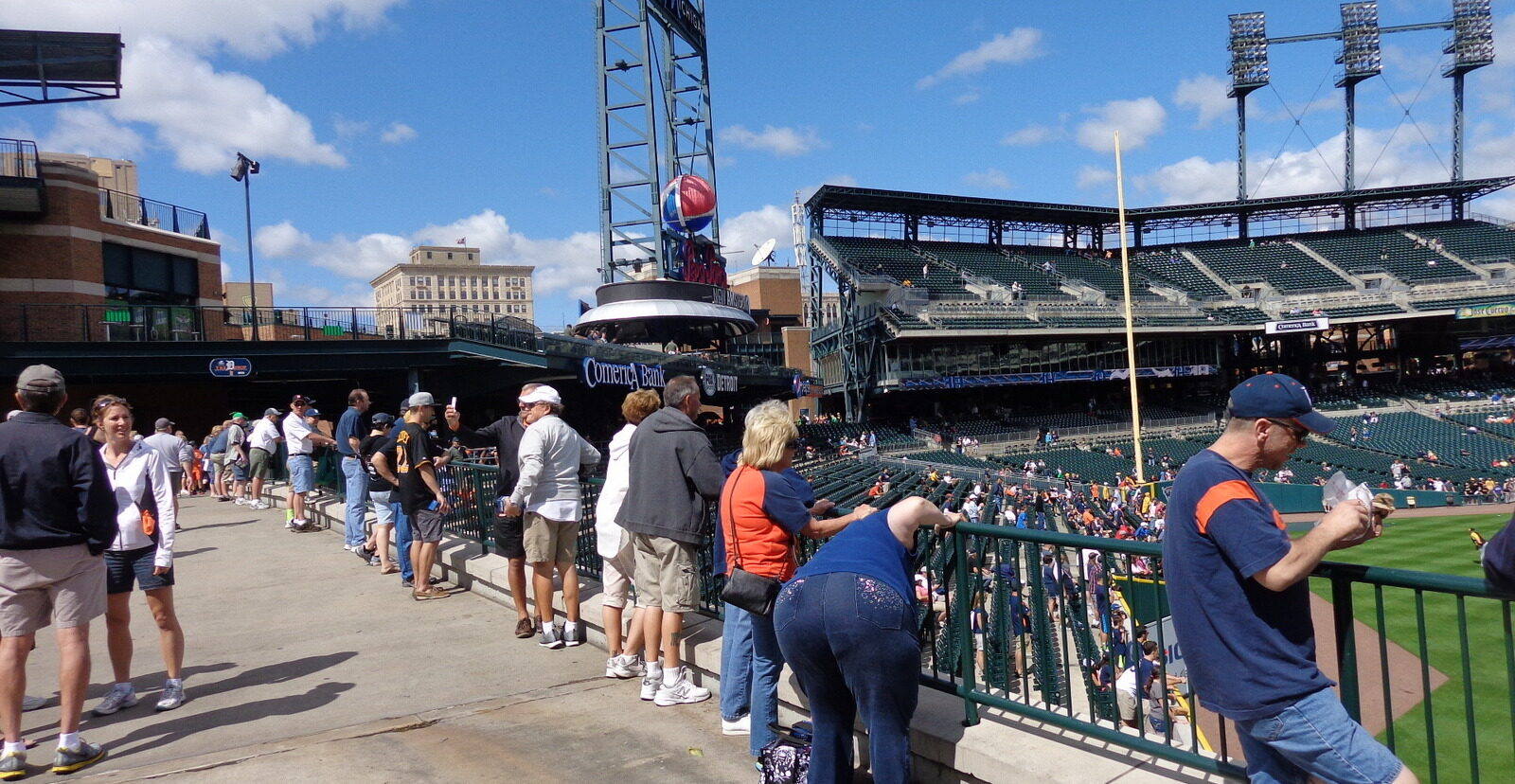
1000s of Baseball's Most Comfortable Seats, Including the Tiger Den Chairs, but Also Many Non-Premium Seats

Outstanding Series of Restaurants, Bars, and Social Spaces Accessible to all Fans
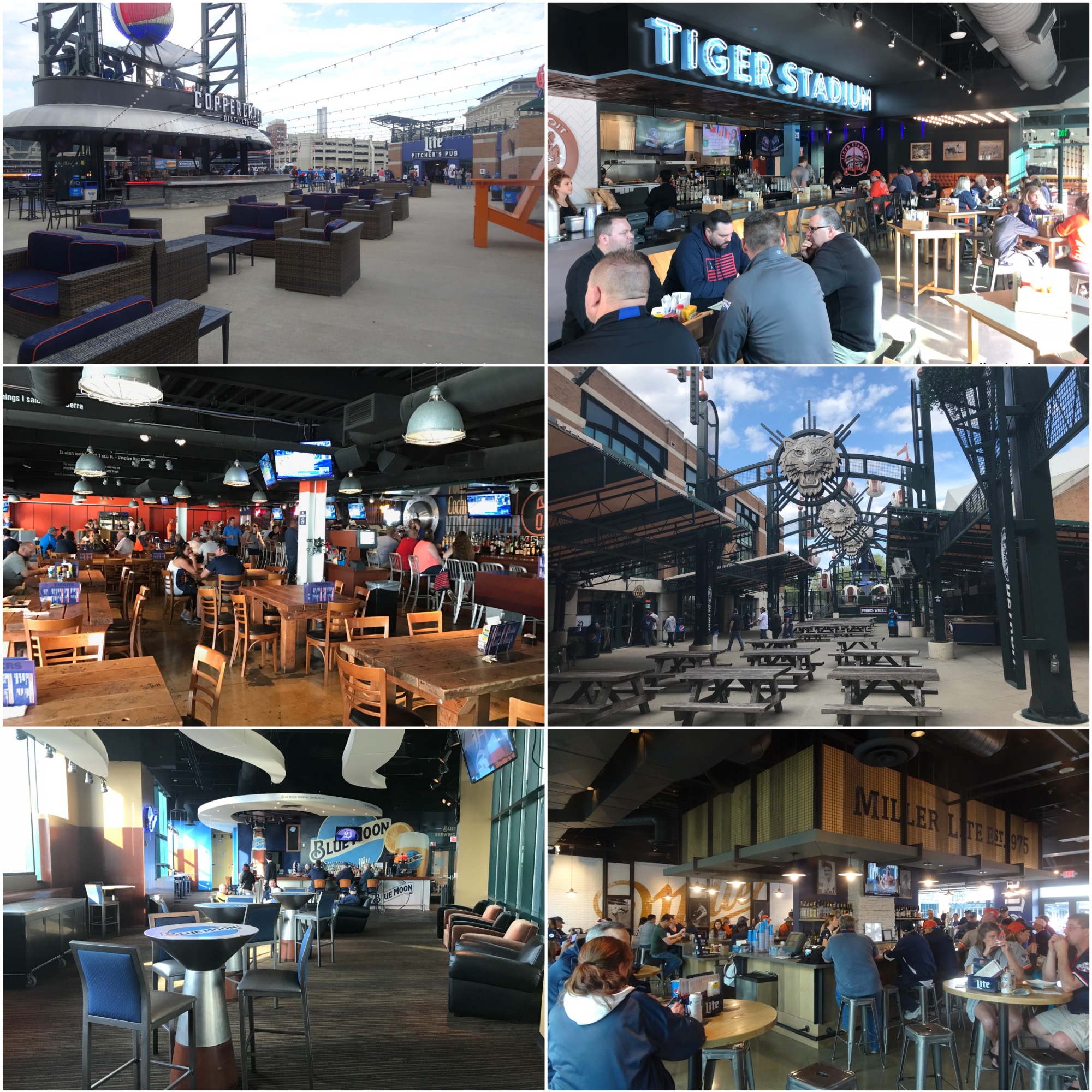
Top-10 Craft Beer Ballpark

One of the Most Egalitarian Seating Structures In MLB
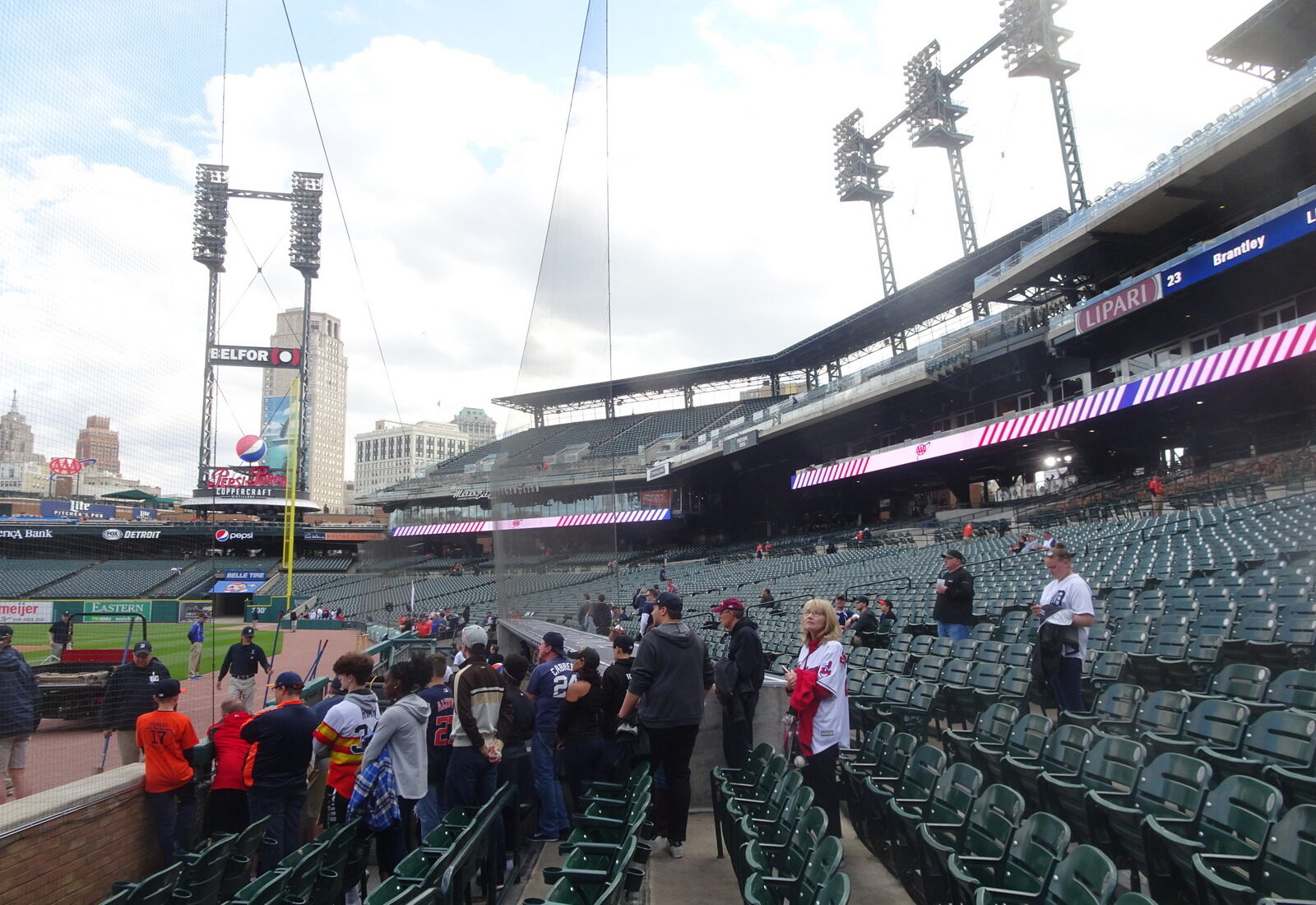
Ferris Wheel
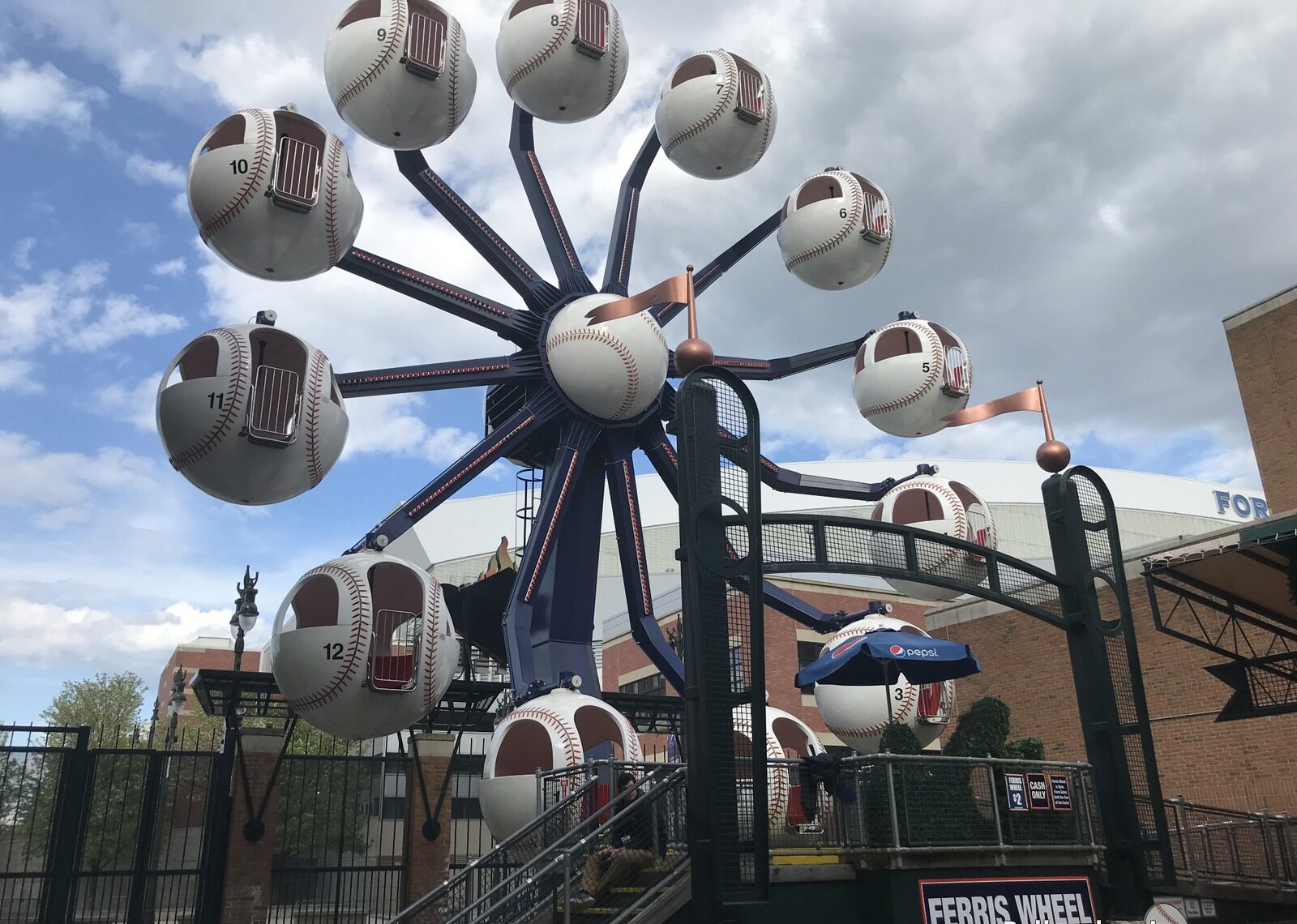
Carousel
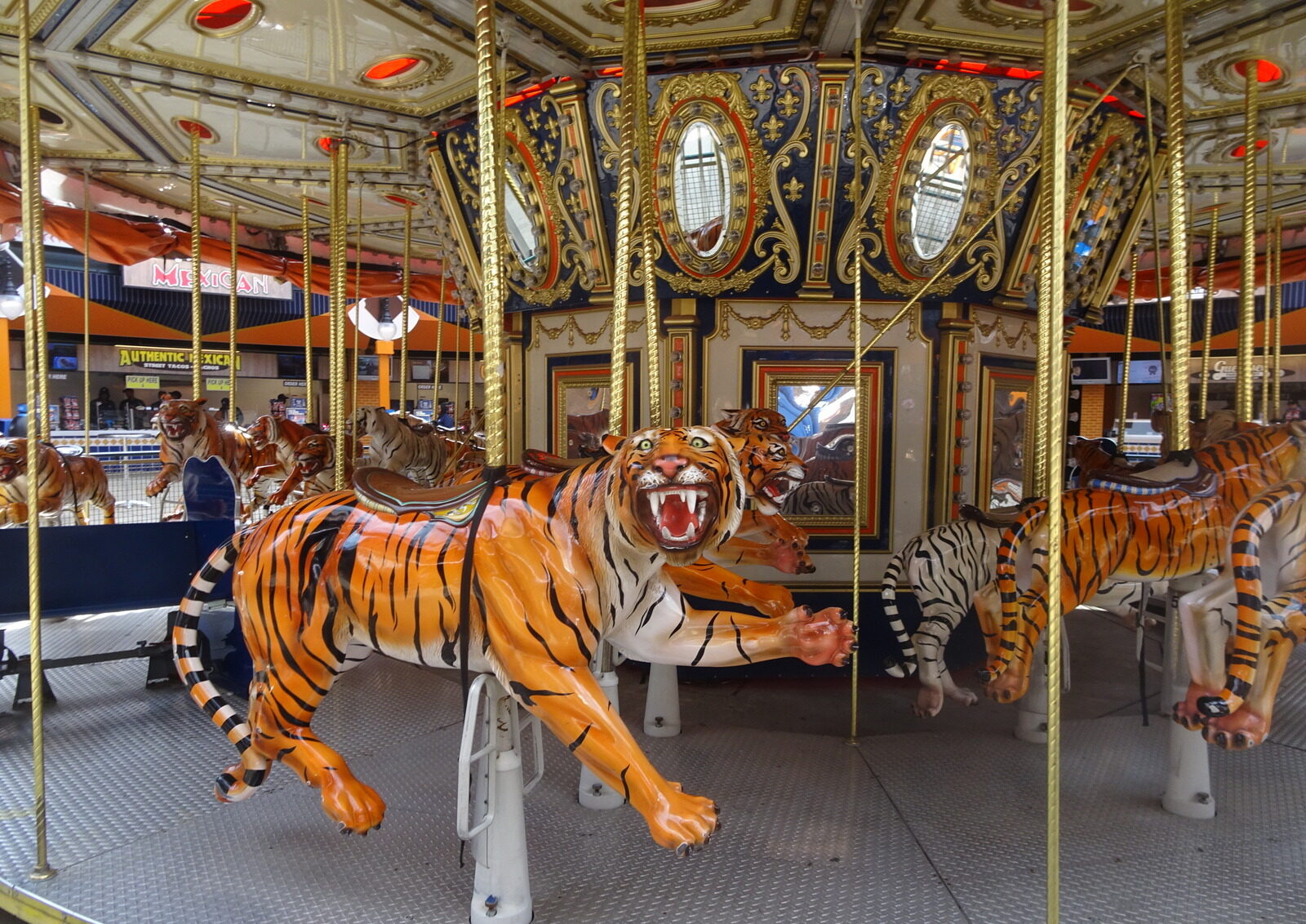
Downtown Locale With Plenty of Historic Attractions and Vibrant Bar Scenes Nearby
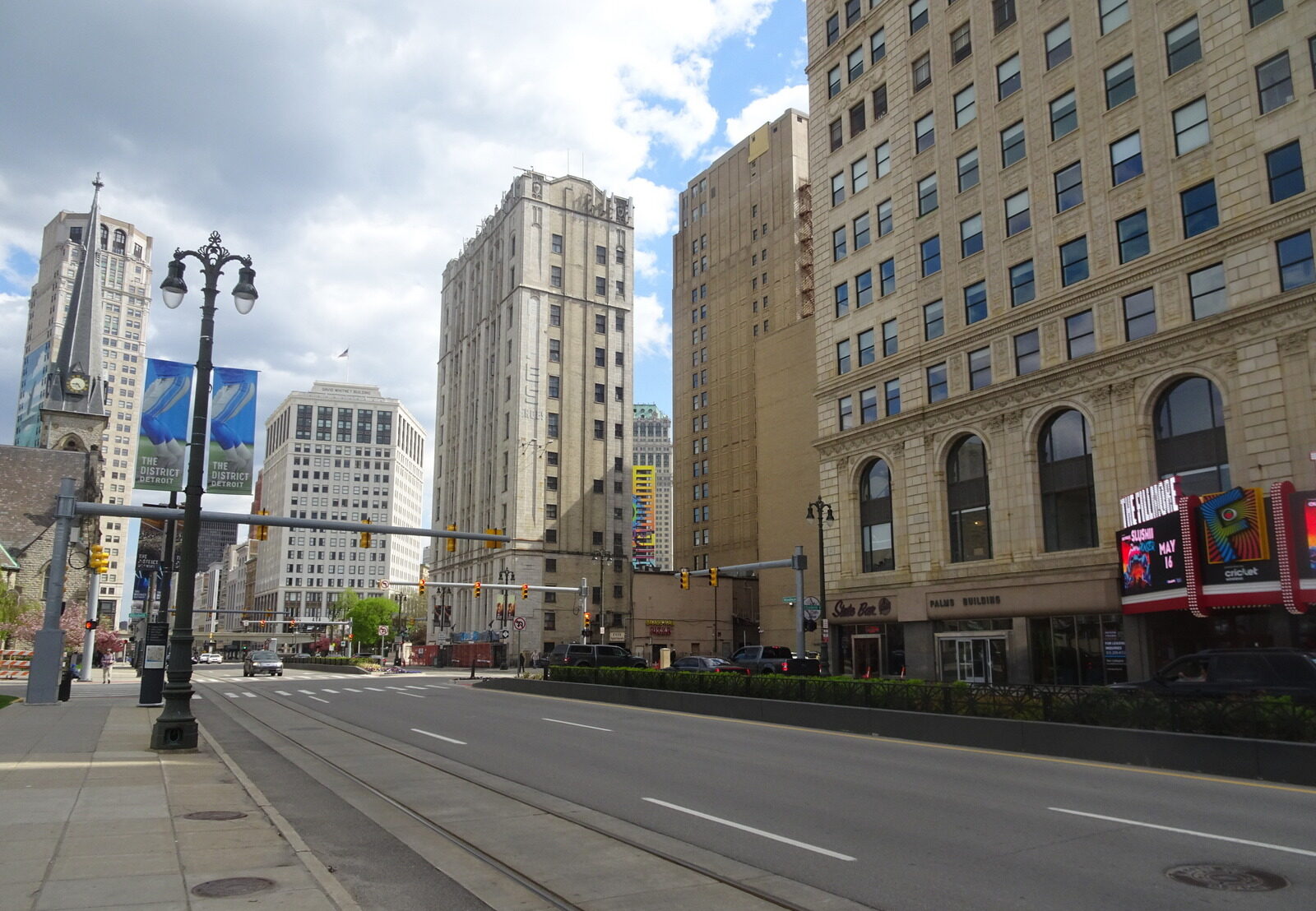
Other Misses
Brutal Sun Exposure During Day Games
Main Concourse Gets Too Narrow in Center Field
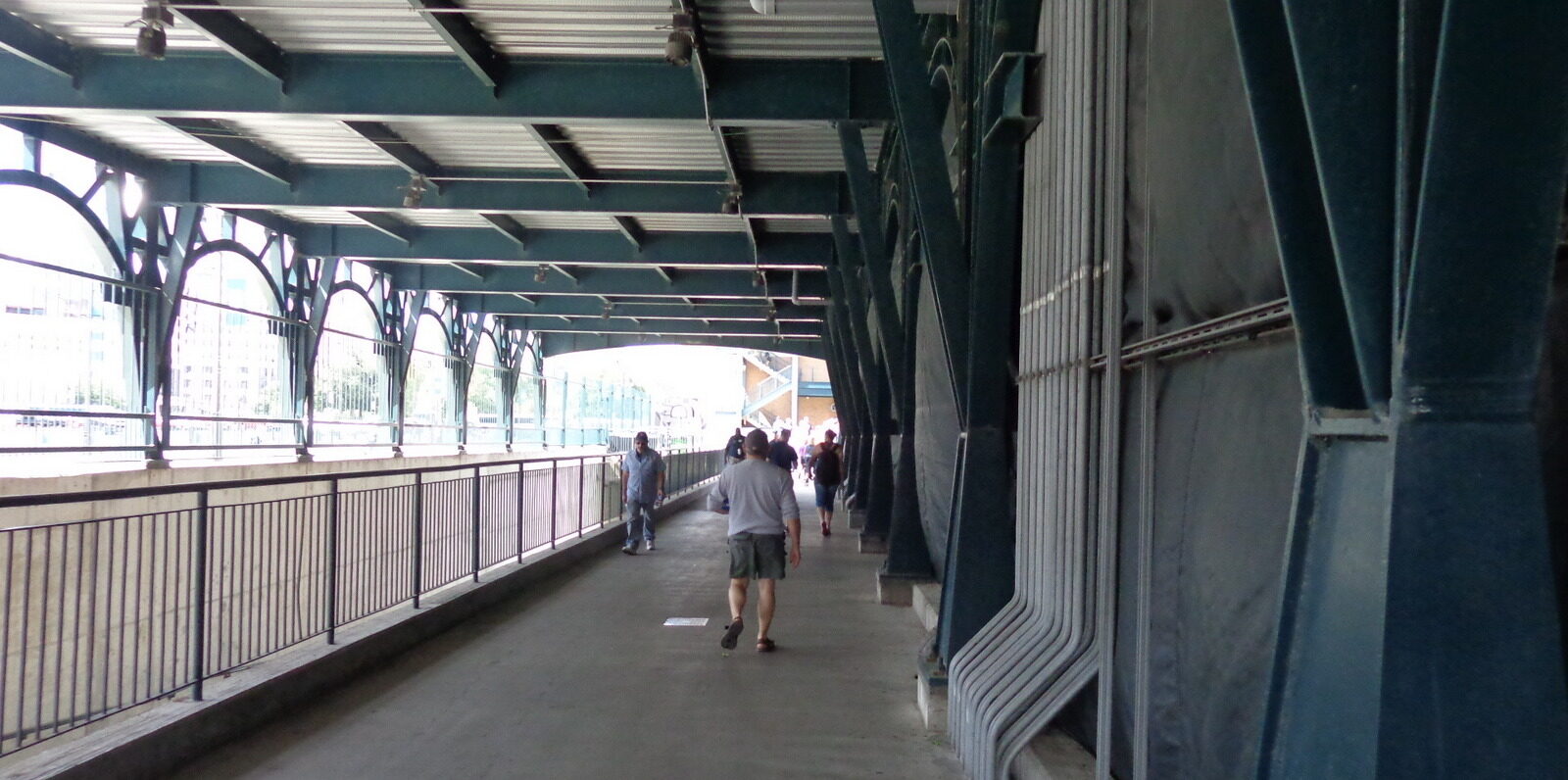
Food Quality Needs Improvement
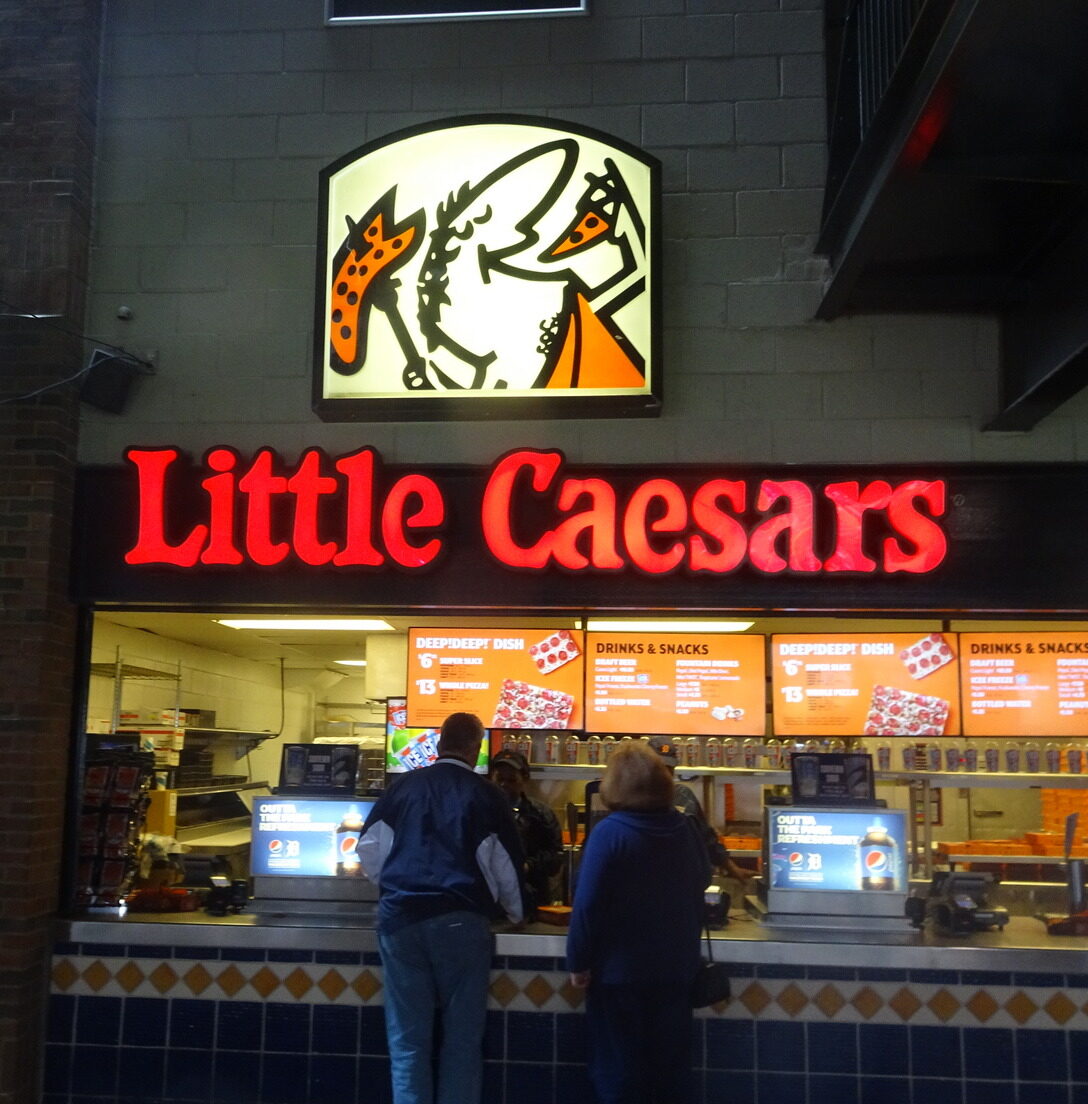
Premium Seating Model is Outdated
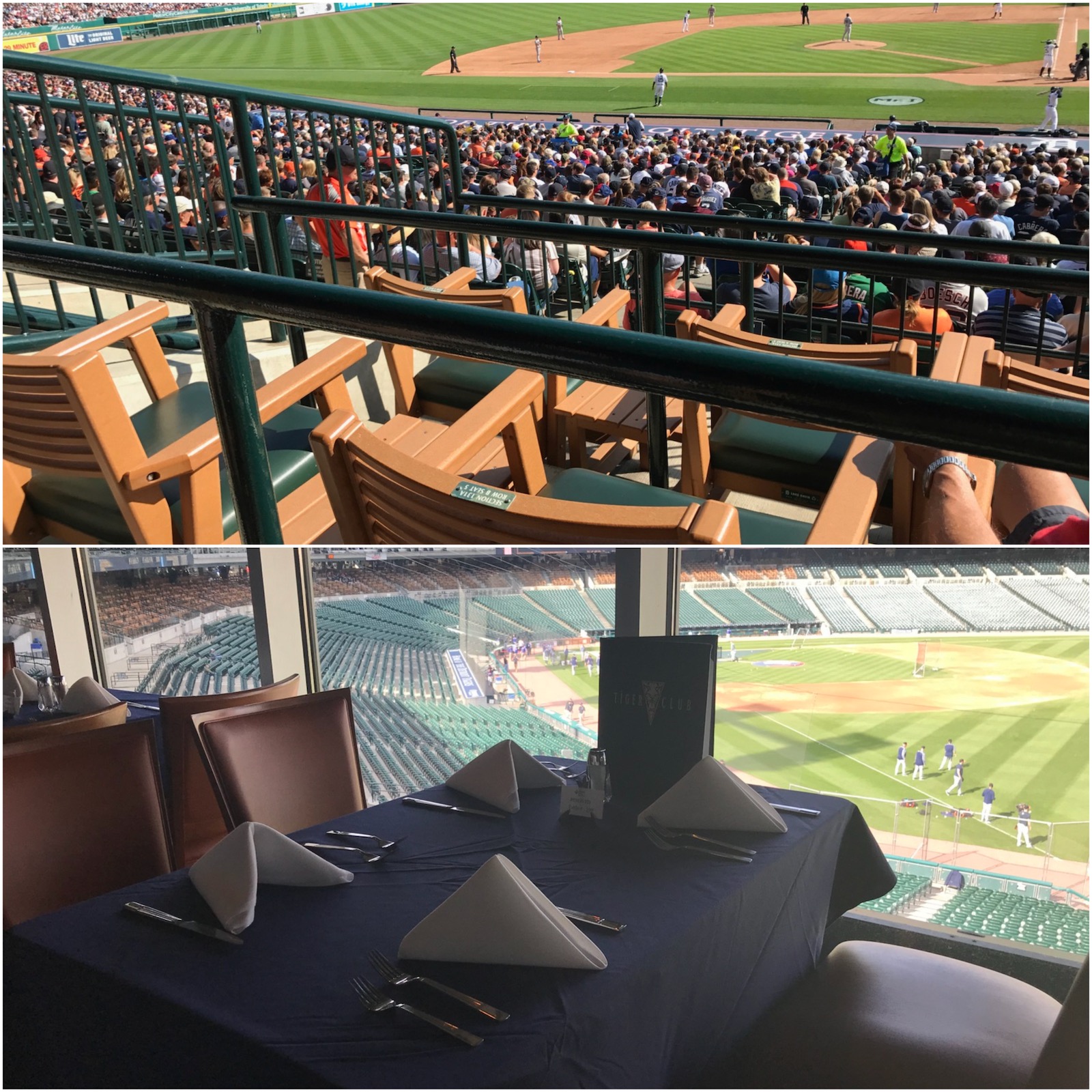
Needs More Maintenance: Signs of Wear and Tear Beginning To Show and Some Interior Club/Bar Spaces Badly Need a Renovation
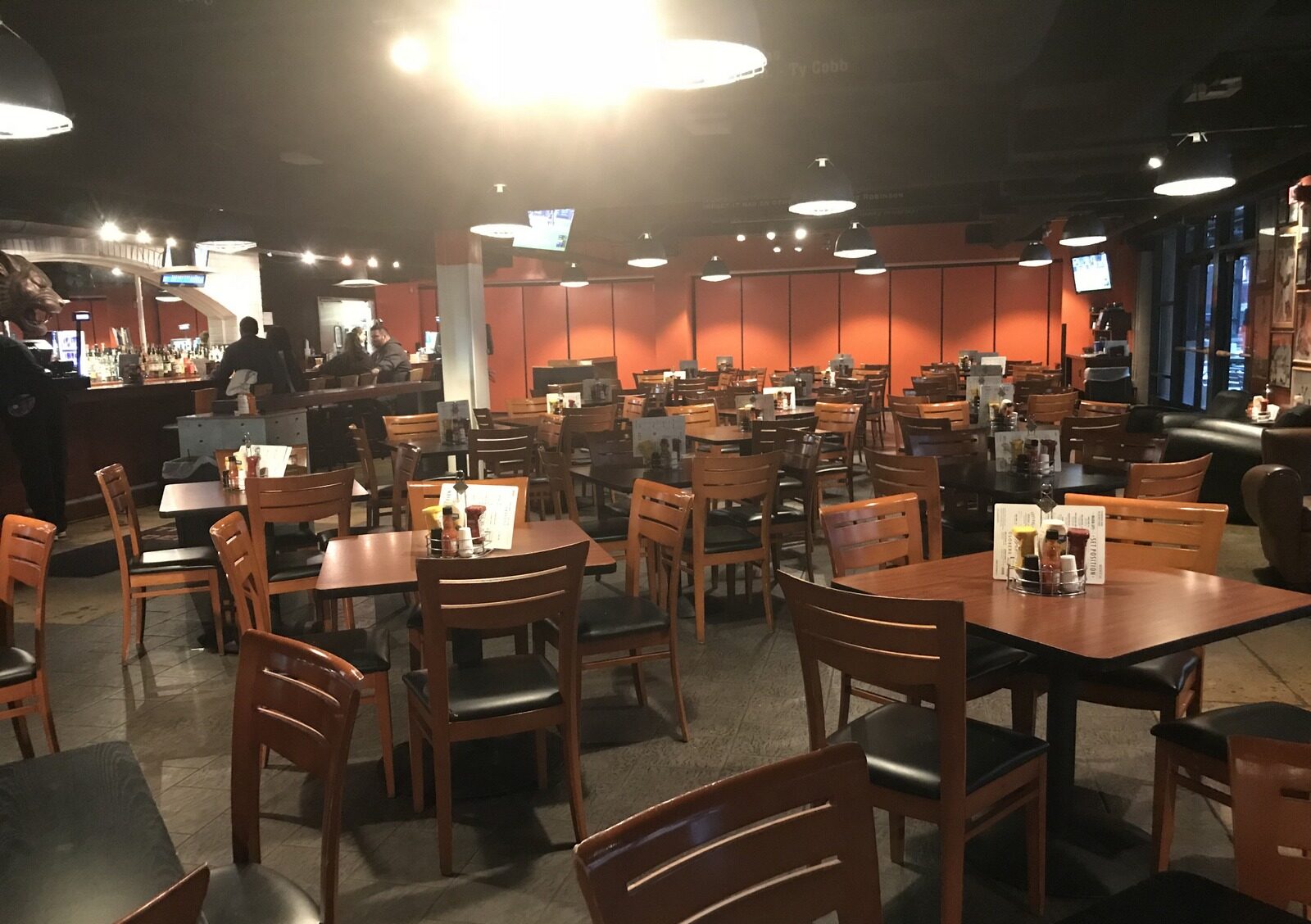
Best of
Best Neighborhood Restaurant/Bar: TBD
Best Seats: Tiger Den
Favorite Seats: “Club” Seats, around section 327-332, behind home plate to slight third base side
Situated in the lower part of the upper deck, this is the best value in the park. Now, let’s be clear: these shouldn’t be called club seats. Their designation as such traces back to club amenities they had when the park opened. But they still have some club seat attributes that make them a great value. They’re wider. They’re padded. And with Comerica Park’s upper deck structure being lower than most, they’re relatively close to the action, while still offering postcard skyline views. I look for value. I like to be slightly elevated. And Comerica’s lower bowl has some problems. So, this is a slam dunk for me. Plus, Comerica’s upper level concourse amenities are decent, and these seats offer quick stairwell access to lower level amenities.
Signature Food: Gyros
klk